It’s common to want a Bible in a different size. Many publishers have realized the value of this and are producing their editions in both large and small versions, and sometimes in a mid-size version as well. The Bible that I’ve heard the most requests for a large print is the TBS Westminster Reference Bible. I consider the Westminster to be the best reference Bible on the market (it’s hard to beat its 200,000 contextual cross-references), so to get the Westminster in large print is a prayer answered.
The Large Print Westminster is available in hardcover and calfskin. I’m reviewing model 120LP/UBK, black calfskin ISBN: 9781862284753, made in Belarus by PrintCorp.
Your first question will be “why is this made by PrintCorp instead of Royal Jongbloed?” This is due to the size of the Bible. The page size is too large for Royal Jongbloed’s equipment, so they were unable to print and bind it.
The follow-up question will be “does it use the same materials as the other editions?” And the answer is yes, it does. The paper does look and feel ‘slightly’ different to me, but this Bible absolutely fits well with the TBS lineup of Bibles.
Trinitarian Bible Society provided this Bible in exchange for an honest for review. I was not required to give a positive review. My opinions are my own.
_______________________________________
_______________________________________
Video Review
Binding
The cover is black calfskin. It’s soft to the touch. It’s thick and has a small grain with a little bit of texture. It has a paste-down liner. It has no printing on the front. The spine has Holy Bible, Large Print Westminster Reference Bible, the TBS logo, and five bands to indicate spine ribs. The ribs are not raised but they do look nice.
The binding is sewn and has no problems lying open in Genesis 1 out of the box – no breaking in required.
It includes four ribbon markers: two black and two red. The overall size is 10.75 x 7.8 x 1.5” and it weighs 3 lbs 8.4 oz. It’s not very thick, but it does look and feel like a large Bible. It comes in a clamshell box.
Paper
The paper is off-white in color and is highly opaque. It feels thicker than my older Westminster. It seems to have a touch more show-through, but I think that’s due to the larger font (more ink on the page). This paper has no glare under any light. The pages are easy to turn. I like to rub the pages together to separate them with one hand and this technique works perfectly for this paper.
I think this would be excellent paper for highlighting and making notes. There are 15 blank pages in the back for notes, outlines, memory verses, events, studies, lists, etc.
Typography
The text is presented in the traditional KJV double-column verse-by-verse. Cross-references are in both the inner and outer margins, creating four columns per page. The header includes the book name and chapter numbers in the outer margin and a page summary in the inner margin. The footer has the page number in the outer margin.
The font is 11.8 black letter with a generous leading. It’s dark and crisp throughout. The font is about the size of the Turquoise, but it’s sharper and not as dark.
It doesn’t have pronunciation marks within the text. It does have a pronunciation guide in the back. I like this approach because it improves readability and the information is still available if you want it. It does have italics for supplied words. The text also includes cross-reference and footnote keys, and asterisks to indicate an updated word in the margin.
The text has 32 characters across with around 5-7 words per line. The text never feels cramped. There are 54 lines per page. There’s enough inner margin that the references don’t get lost in the gutter. It’s printed with line matching to improve readability.
Front-Matter
In the front are a couple of thick end sheets with Scriptures, a Presentation page, the Epistle Dedicatory, characteristics of the Authorized Version, a guide to using the Westminster Reference Bible, and a list of books and their abbreviations. It doesn’t have the Translators to the Reader. The characteristics and guide provide good information that helps in using and understanding the KJV.
Characteristics of the Authorized Version
This section covers KJV features such as italics, Lord vs. LORD; God vs. GOD, capitalization, OT names in the NT, Thou and Ye (includes thee, thy, and thine), and the pilcrow (paragraph marker). Most of these are explained in detail and give Scripture references as examples.
Guide to Using the Compact Westminster Reference Bible
This section covers book titles, chapter summaries, why psalm headings are included, why subscriptions to the epistles are excluded, references in the margins (most are taken from John Brown’s The Self Interpreting Bible and the rest from the Concord), and further content in the margins (which includes the translator’s footnotes and updated words).
It also includes a sample page and highlights running page heads, chapter summaries, superscript letters, superscript numbers, asterisks, and superscript section markers, showing how they work and how to use them.
Cross-References
Where the Large Print Westminster really shines is its 200,000 cross-references. Most are from John Brown of Haddington’s The Self Interpreting Bible and the rest are from the Cambridge Concord. They’re placed in the inner and outer columns as close as possible to the verses they correspond to. They’re keyed to the text with letters.
They’re contextual and they include larger passages rather than just portions of verses. So, if you don’t see a reference next to a verse look at the beginning of the context. I like this because it allows Scripture to interpret Scripture. These are my favorite references in any Bible. They’re excellent for study and sermon prep.
Here are a few examples to help you compare. Some of these references are repeated within the same verse, but they actually correspond to different places within the verses.
- Genesis 1:1 – Ps 33:6, 9; 136:5; Jn 1:1-3; Col 1:16, 17; He 1:8-10; 11:3
- Deuteronomy 6:4 – 1 Ch 8:6; Mar 12:29; Je 10:6-11; Is 42:8; 45:22; 1 Jn 5:20; Jn 17:3; 1 Co 8:4, 6
- Isaiah 9:6 – ch 7:14; 4:2; Lu 2:11; Mat 15:24; Ro 9:5; 15:8; Jn 1:14; 3:16; 4:10; 6:32, 33; 2 Co 9:15; Mat 11:27; 28:18; Eph 1:22; ch 7:14; 63:1; Jer 31:22; Mat 8:27; Pr 30:4; Ju 13:18; Zec 6:13; ch 28:29; Jn 1:18; 17:8; 15:15; Re 3:18; Lu 7:30; Je 23:6; Ps 45:3-6; Jn 1:1, 2; Ro 9:5; Ti 2:13; ch 45:22; 63:1-4; 1 Jn 5:20; He 1:8; 7:25; Pr 8:23-31; He 5:9; 2:13; Jn 6:39-51; 10:28; 11:25; ch 53:10, 11; Ep 2:10; ch 53:5, 12; Je 23:5, 6; Mi 5:1, 2, 5; Ro 5:1, 10; 2 Co 5:19, Ep 2:14; Jn 16:33; 14:27; Phi 4:7; 2 Th 3:16
- Matthew 17:20 – ch 13:58; 6:3; v 17; He 3:19; Lu 17:6; ch 13:31; 21:21; Mar 11:23; 1 Co 13:2; v 9; ch 21:22; Mar 9:23
- Mark 11:23 – Mat 17:20; 21:21; Lu 17:6; Ja 1:5, 6; Ro 14:19, 20; 1 Co 13:2
- Mark 12:29 – De 6:4, 5; 10:12; 30:6; Pr 23:26; Mat 22:37; Lu 10:27; 1 Co 13; 1 Ti 1:5
- John 1:1 – Ge 1:1; Ps 2:7; Pr 8:22-31; Col 1:16, 17; Re 1:2, 9; 19:11, 13, 16; 1 Jn 1:1, 2; 5:7; He 1:3; 4:12; ch 3:34; v 14; Lu 1:2, Ac 20:32; 2 Pe 3:5; Pr 8:30, ch 17:5; Zec 13:7; ch 10:30, 33; Phi 2:6; He 1:3, 8-13; 1 Jn 5:7, 20; Ti 2:13; Ro 9:5; Is 9:6
- Acts 2:38 – Mt 3:6, 8; Mk 1:4, 15; cha 3:19; 20:21; 22:16; 1 Jn 1:7; Titus 3:5; Isa 1:18; 55:7; Luke 24:47; Mt 26:28; ver 16-18; 8:15-17; 10:44, 45; 16:6
- Romans 1:17 – ch 3:21-26; 5:15-21; 1:3, 4; 2 Cor 5:21; Phi 3:9; 2 Pe 1:1; 2 Co 3:9; Ps 84:7; 2 Co 3:18; Re 22:11; Hab 2:4; He 10:38; Ga 3:20; 3:11; ch 5:1, 2; Ac 10:43; 2 Co 1:24; 5:7; He 11:6, 7
- Galatians 3:11 – ch 2:16; Ro 3:20, 28; 1 Ki 8:46; Ec 7:20
- 1 John 1:1 – Pr 8:23; Mi 5:2; Jn 1:1, 2: Re 1:8; Is 41:4; 44:6; 2 Pe 1:16, 18; Mat 3:16, 17; Lu 24:39; Re 1:2; Jn 1:1, 14; 5:26, ch 5:7; Re 19:13
Footnotes
The translator’s footnotes are placed in the margins next to the verses they correspond to and are keyed to the text with numbers. They include Hebrew and Greek words with explanations, alternate renderings, more literal translations, etc. I’m glad they’re included because they are helpful in understanding some of the translation choices.
Marginal Wordlist
Rather than placing that glossary in the back of words that are no longer in use or have changed meaning, the Westminster places updated words in the margin on the page where the word appears. They are keyed to the text with an asterisk. The margins include the asterisk, the original word, and a short definition.
I like this approach. I don’t always know to look at a glossary in the back because sometimes the current meaning of a word can still fit in the context even though the older definition was how the translator’s meant for us to understand it.
Tables of Weights and Measures
In the back is 5.5-pages of tables for weights and measures. They show the type of measure, equivalent Old Testament measure, equivalent New Testament measure, Hebrew and Greek words, approximate equivalent Imperial measure, approximate equivalent metric measure, biblical references, and the time that’s covered. The margins of the Bible includes a symbol to tie the text to these tables.
Tables include:
- Old Testament Weights
- Old Testament Lengths
- Old Testament Liquid Measures
- Old Testament Dry Measures
- Old Testament Money
- Old Testament Time
- New Testament Weights
- New Testament Lengths
- New Testament Liquid Measures
- New Testament Dry Measures
- New Testament Money
- New Testament Time
List of Words and Proper Names
Rather than having a self-pronouncing text, the Westminster has a 15-page list of words and names with self-pronouncing marks. It shows the syllables and shows how to pronounce consonants, blends, and nouns. It contains every name and foreign word. It also has a chart to show how to pronounce the symbols.
Reading Plan
In the back is the M’Cheyne reading plan. This is a two-year plan that takes you through the Old Testament once and the New Testament and Psalms twice. The first year starts with Genesis and Matthew, and the second year starts with Ezra and Acts. It can also be used as a one-year plan, which would give you 4 readings per day with all four readings from different places in the Bible.
Maps
There are 8 colorful maps on thick non-glossy paper. The colors are bright and can seem a little cartoonish. I like this design a lot. It doesn’t have an index but the maps are annotated well and the names are printed very large. Maps include topography, distance, water, routes, capitals, borders, Scripture references, commodities, trade, subjection, royal residence, fortresses, events, dates, etc.
Maps include:
- Time of the Patriarchs
- The Exodus
- The Twelve Tribes of Israel
- Undivided Kingdom
- Kingdoms of Israel and Judah
- The Persian Empire
- Holy Land in the Time of Christ
- Paul’s Missionary Journeys
Comparisons
Here’s a look at how the Large Print Westminster compares to a few other large print KJVs. I’ve also included the regular Westminster, Compact Westminster, Large Print Thompson Chain Reference, Turquoise, Canterbury, Thomas Nelson Giant Print, and Longprimer.
Large Print Thompson Chain Reference
The Large Print Thompson Chain Reference Bible is about the same size. It has a smaller font and the paper isn’t as opaque. It has 100k forward-moving chain references.
Cambridge Turquoise
The Turquoise font is about the same size. It’s darker, but could be too dark for reading in good lighting for long periods of time. It has under 44k references.
Canterbury
The Canterbury also has a line-matched digital font. It has a more elegant paper, but it doesn’t include translator’s footnotes. It has 55k references.
Longprimer
The Longprimer’s font is slightly smaller but it’s darker. It doesn’t have as much white-space in the text, making it feel more crowded. It has 100k chain references that move forward and backward.
Premier Collection KJV
The Premier Collection Giant Print Reference has a similar font but it’s slightly darker. It has under 60k references (just a guess though).
Westminster
The regular edition has a 9.6 font and a concordance. The regular and large print both make a great combo – one for preaching and study and one for carry.
Compact Westminster
The Compact Westminster has a 7.3 font. It’s a lot smaller Bible but it’s great for carry.
Conclusion
The Large Print Westminster Reference Bible is a large Bible that fills the need for those who prefer large editions. For me personally, it’s a touch large for carry, but if you’re used to carrying a large print Thompon then you won’t have any issues carrying this one. For me, it really shines for study and preaching. The only thing missing is the concordance, but the 200,000 cross-references do help make up for that as a Bible for study. Even though the large print edition isn’t made by Royal Jongbloed like the other two editions are, the quality is still there. Print Corp did a great job with this edition.
I love that they now produce the Westminster in three different sizes. Together, they make an excellent combination for carry, reading, study, and preaching, and this means that there’s an edition for everyone in the family or ministry team. I highly recommend the Large Print Westminster Reference Bible to anyone looking for a quality cross-reference KJV in large print.
_______________________________________
_______________________________________
Trinitarian Bible Society provided this Bible in exchange for an honest for review. I was not required to give a positive review. My opinions are my own.


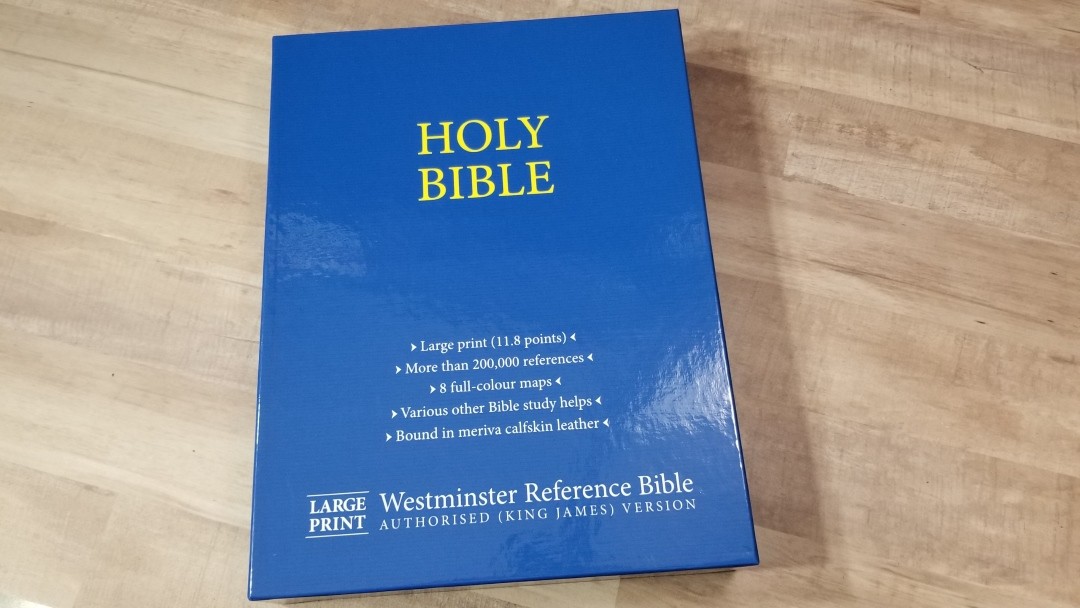
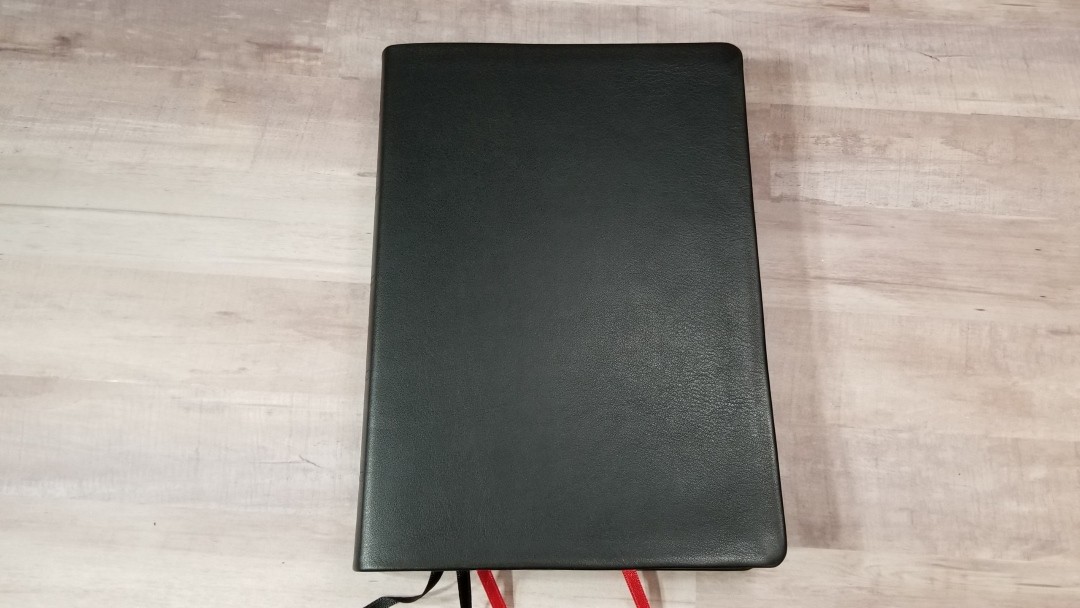
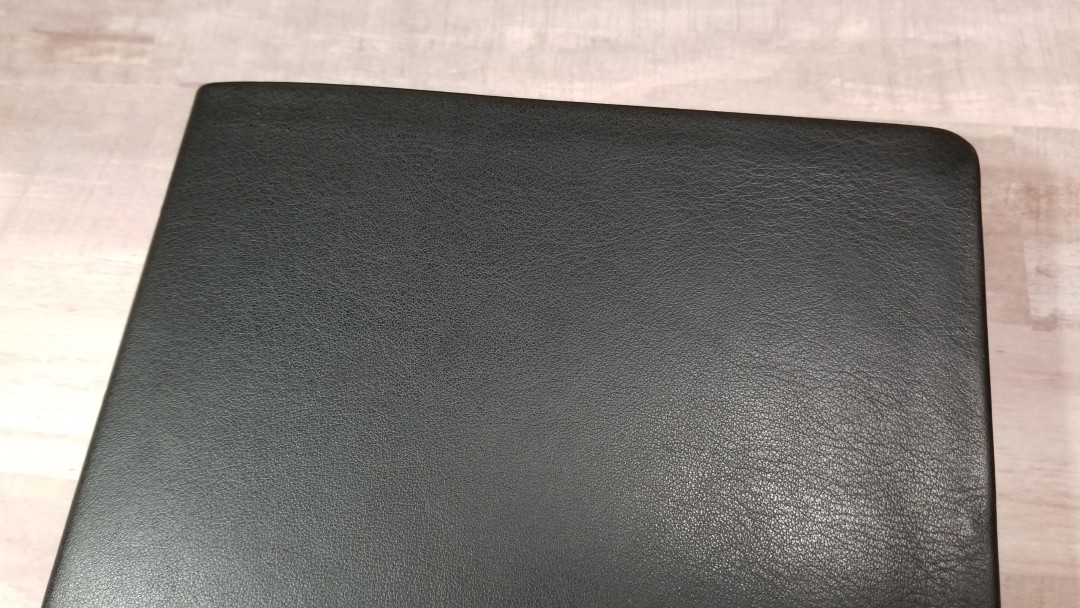

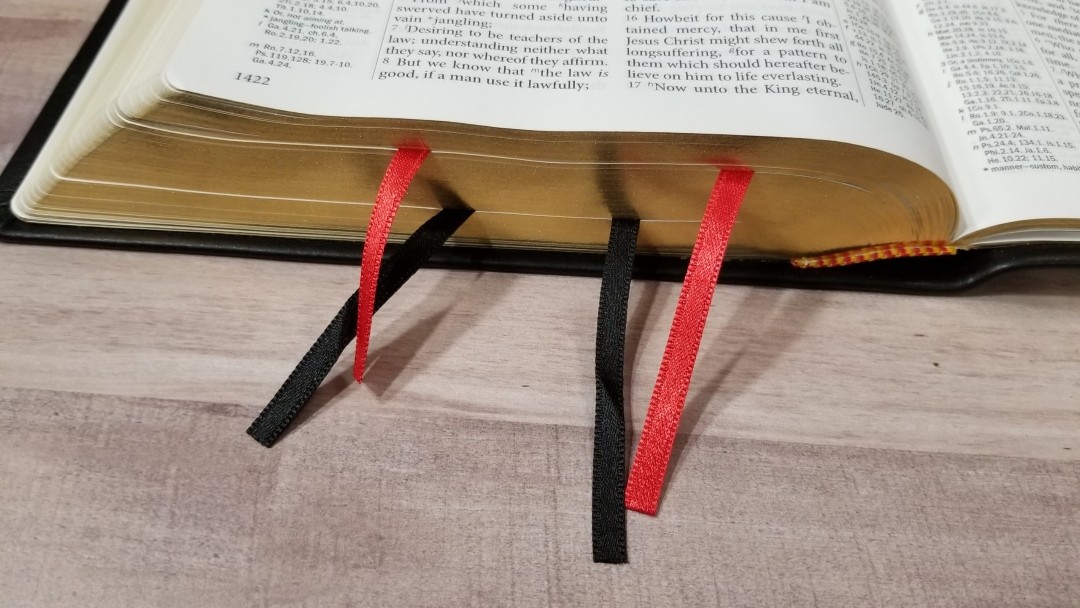
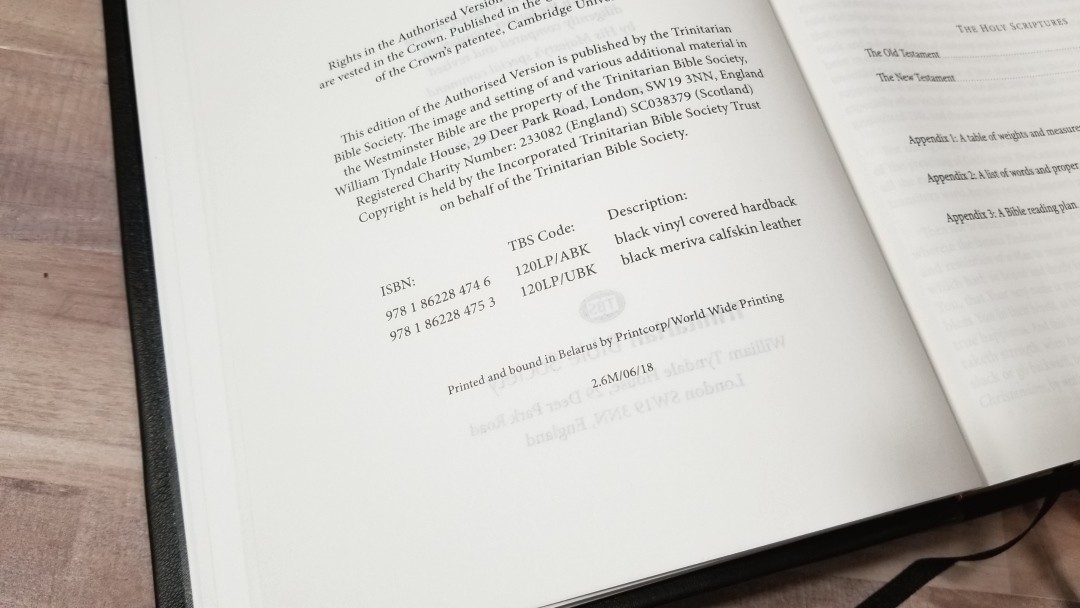
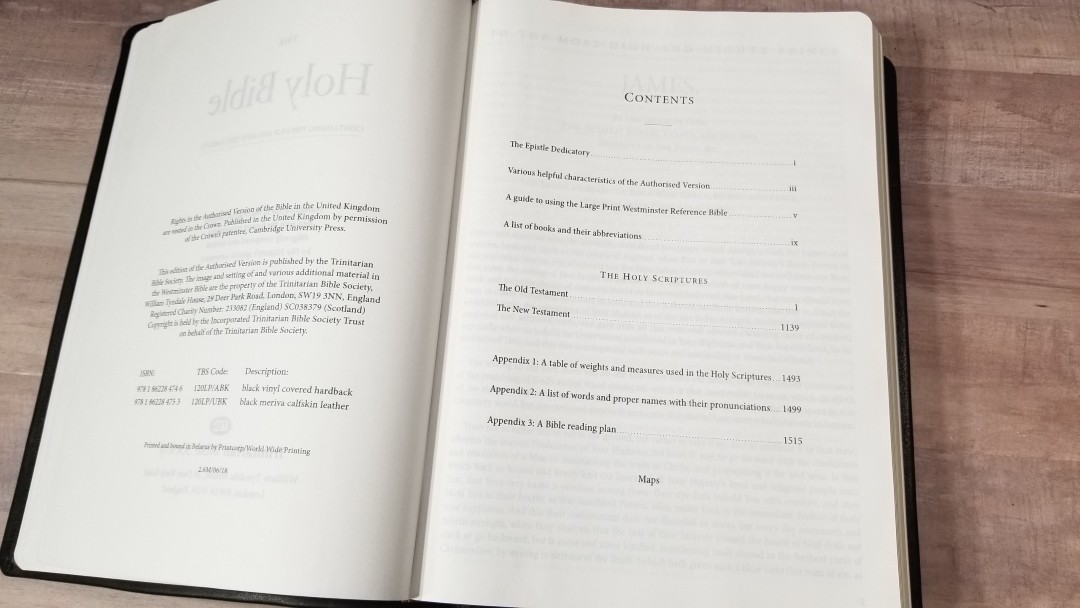
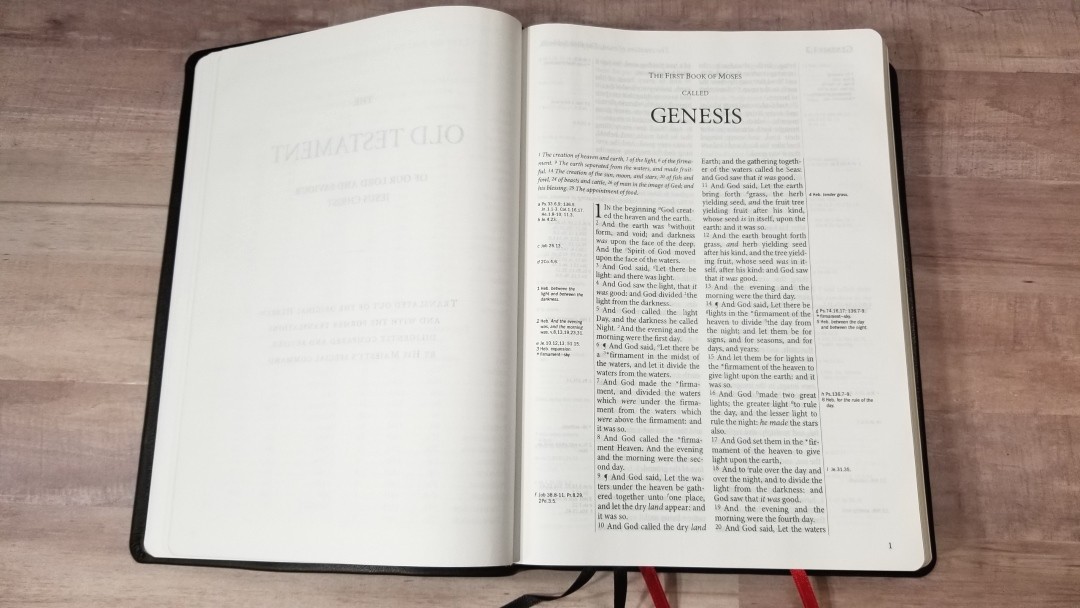
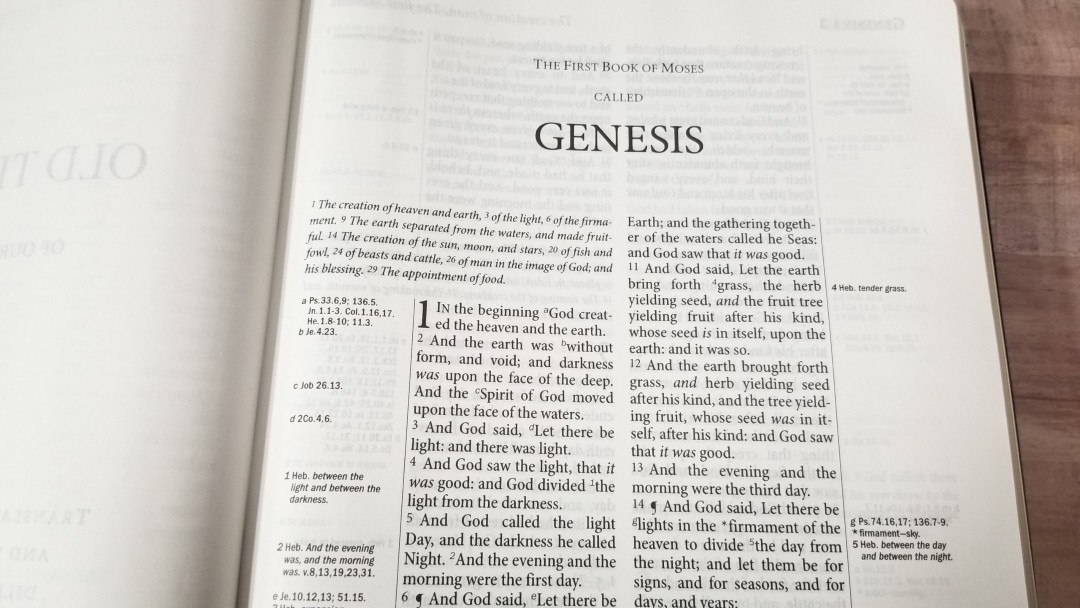
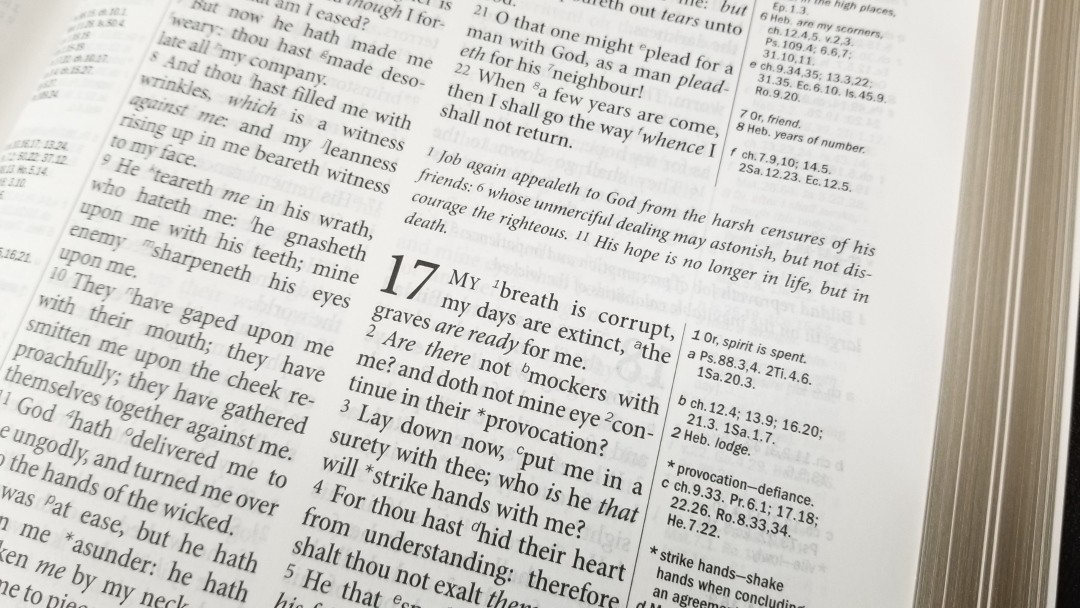
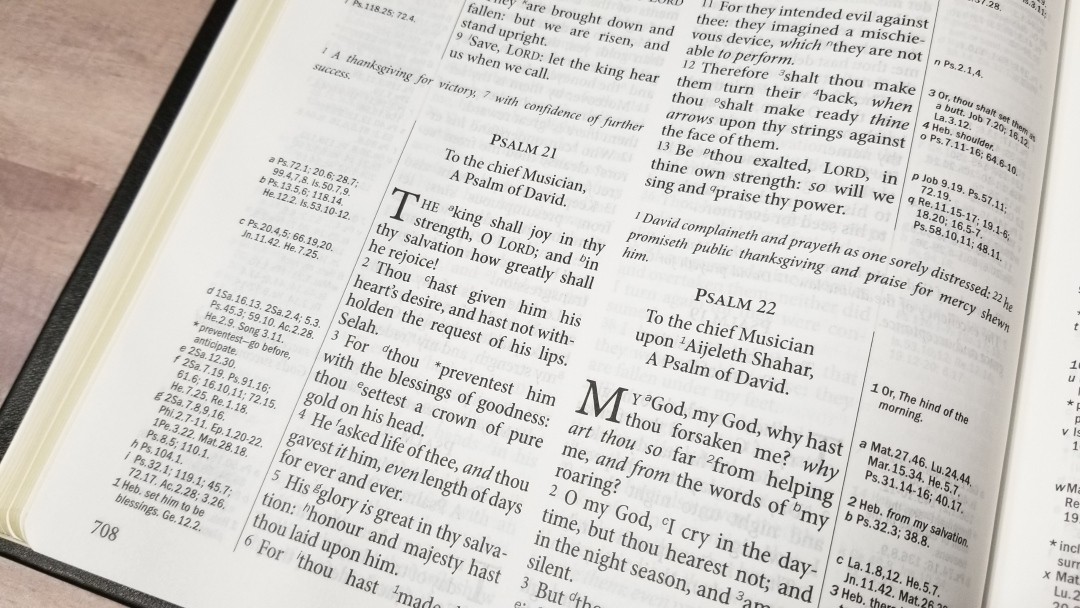
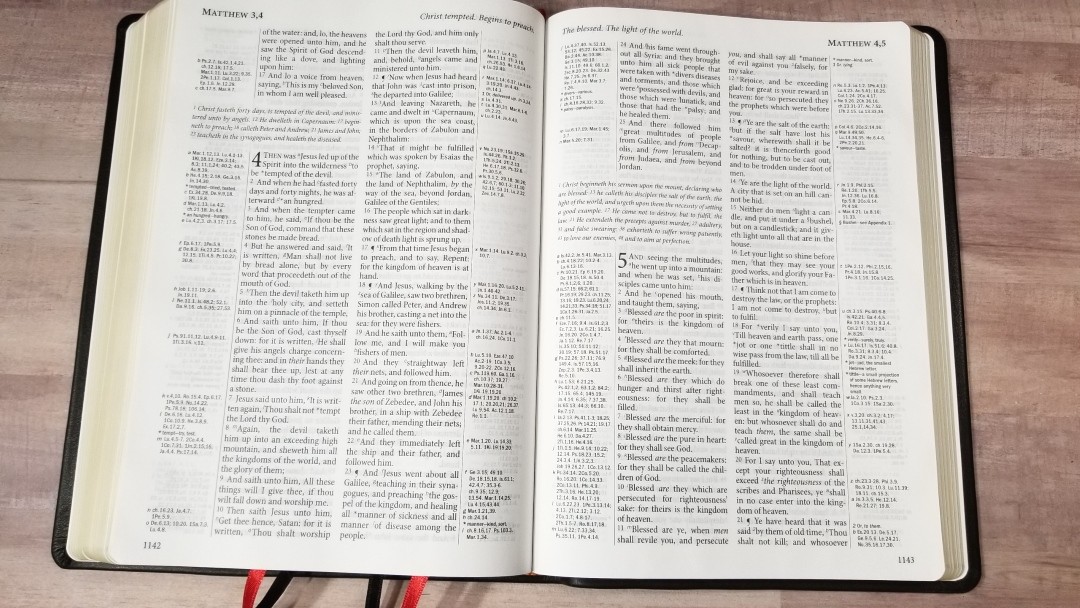

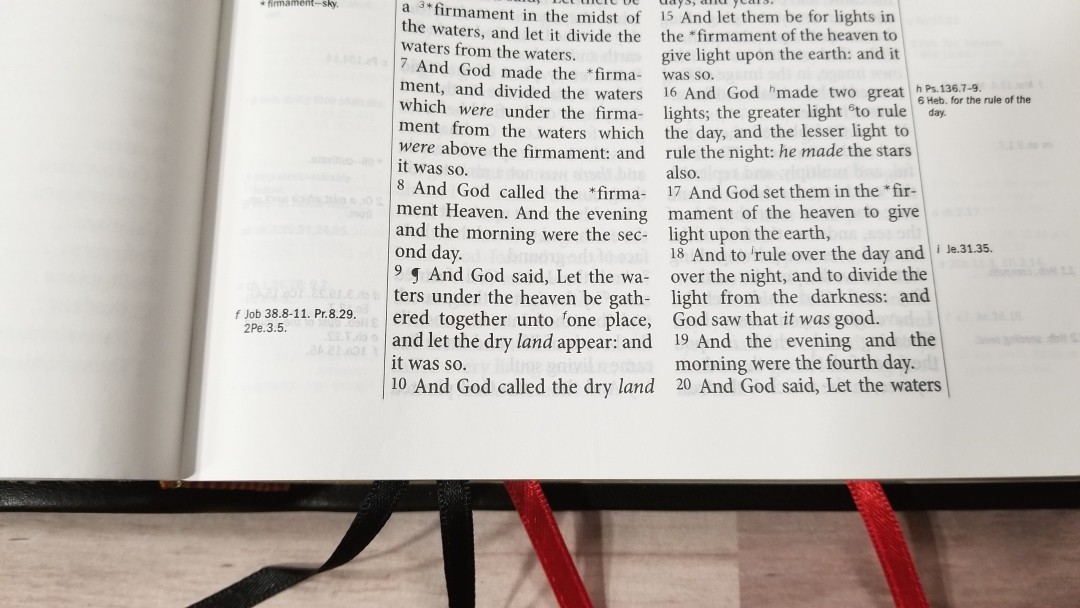


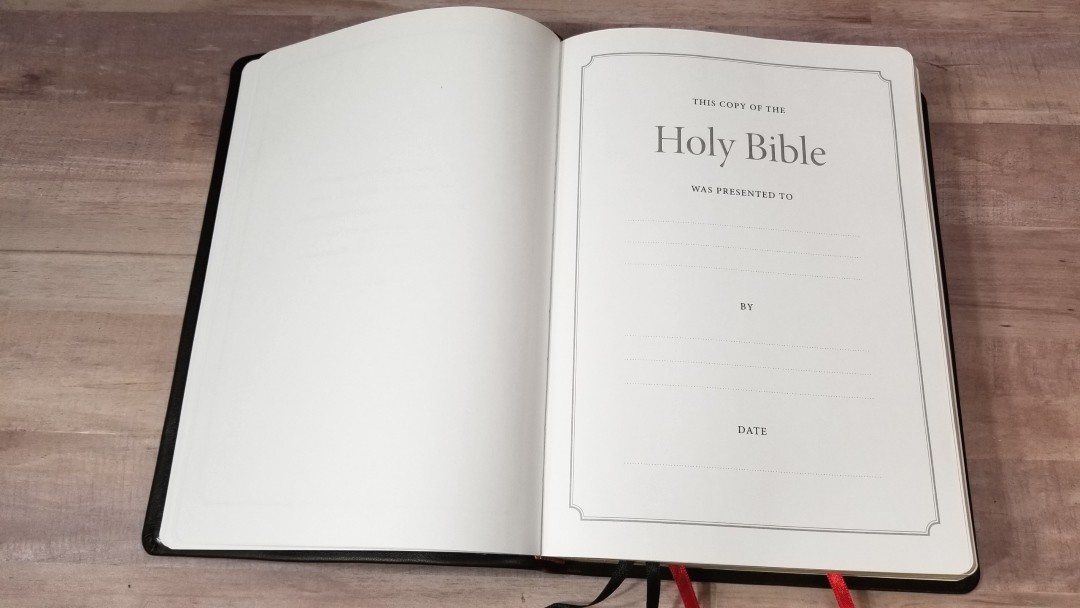
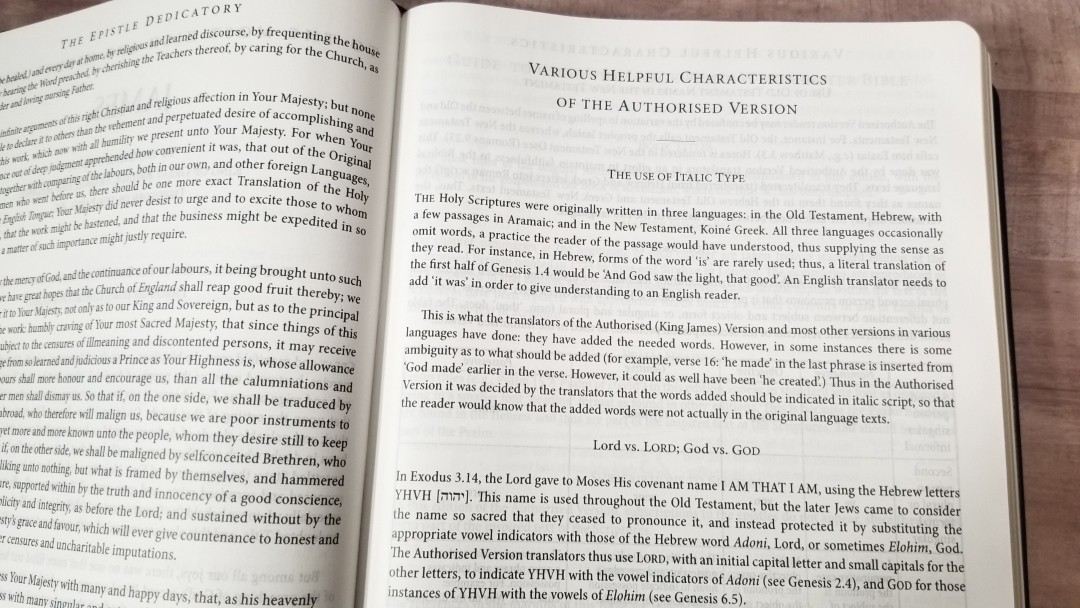
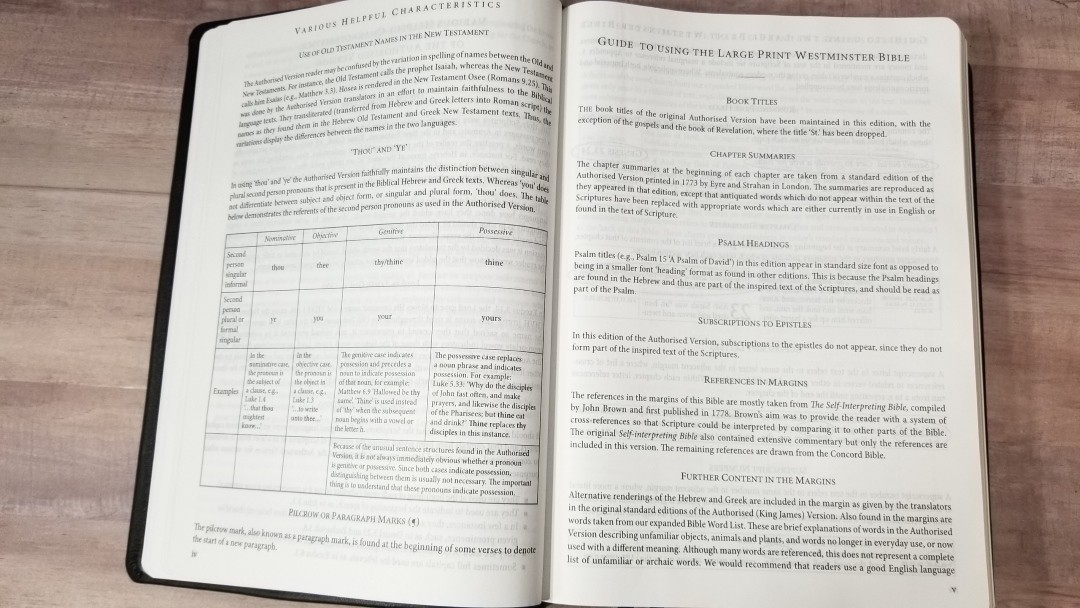
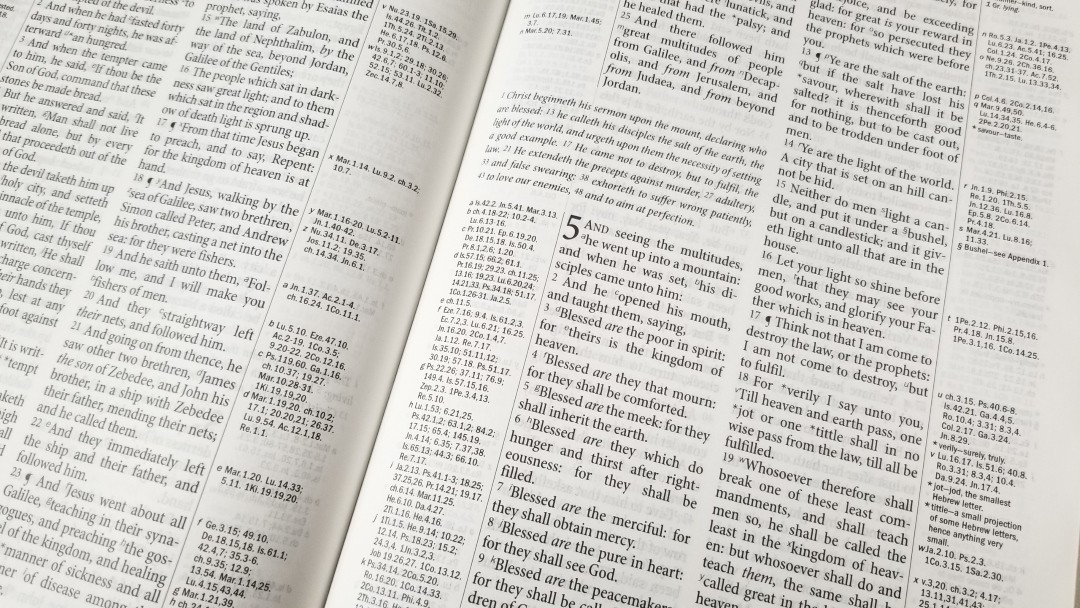
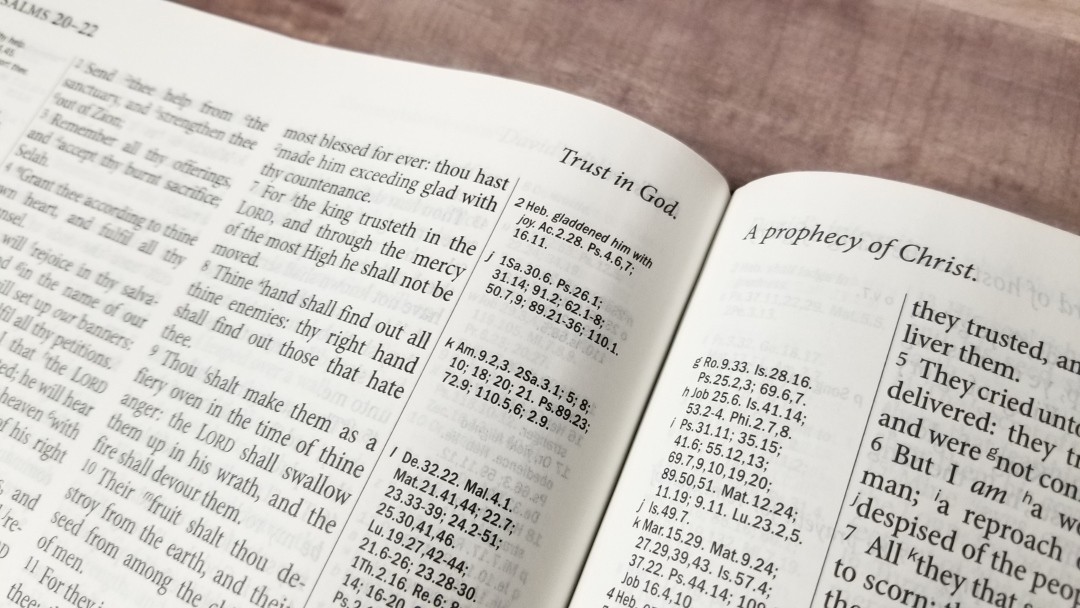
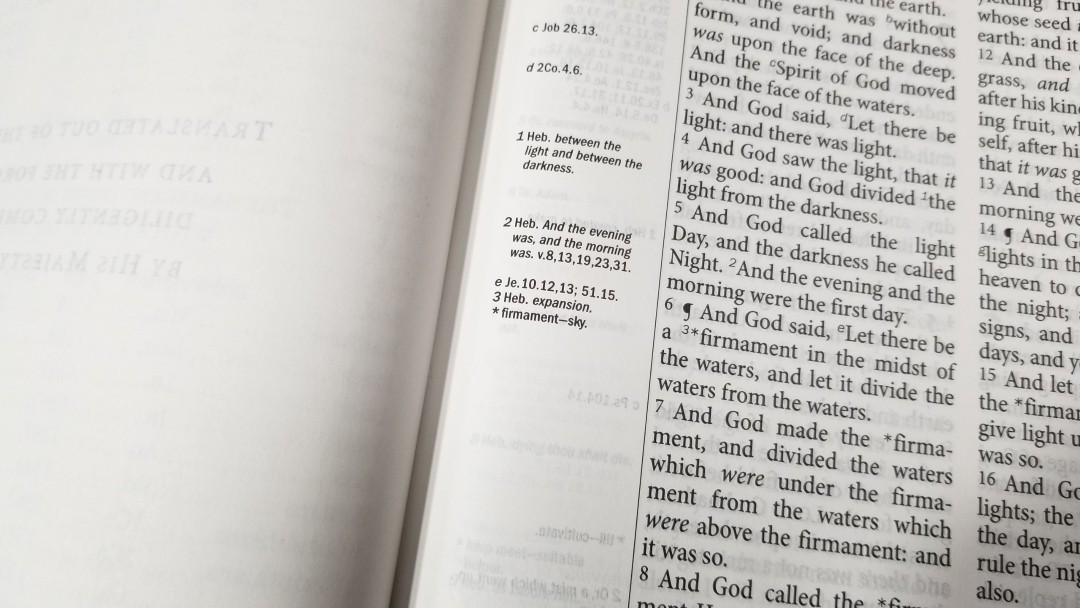
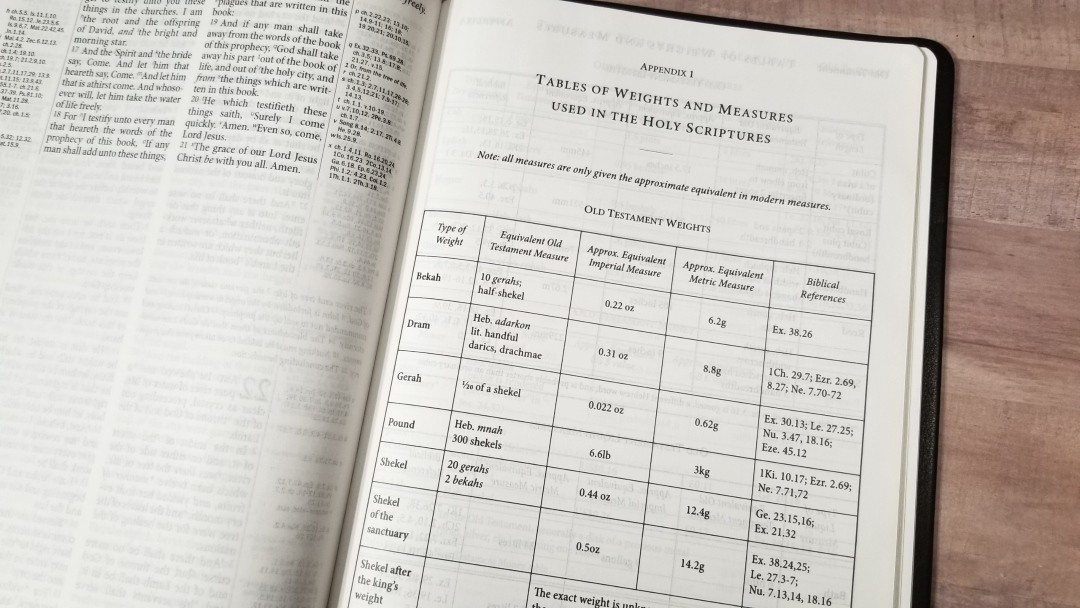
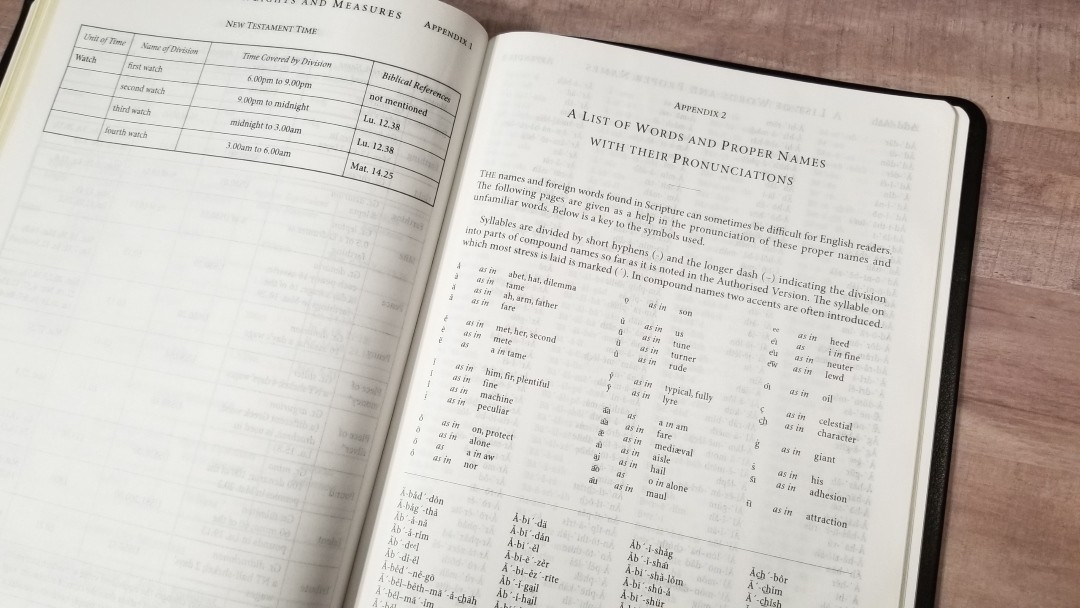
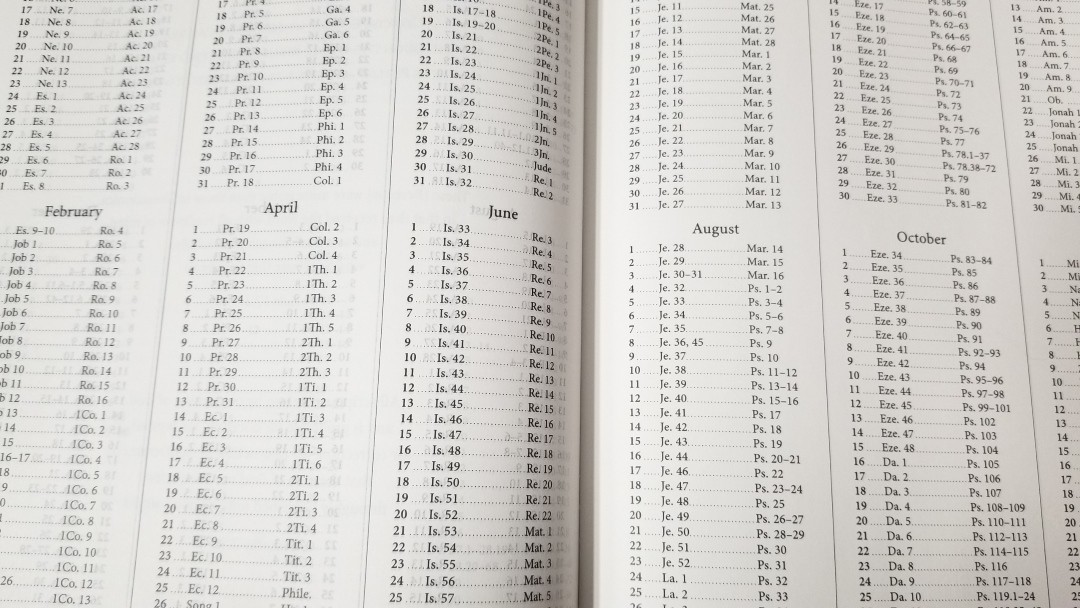

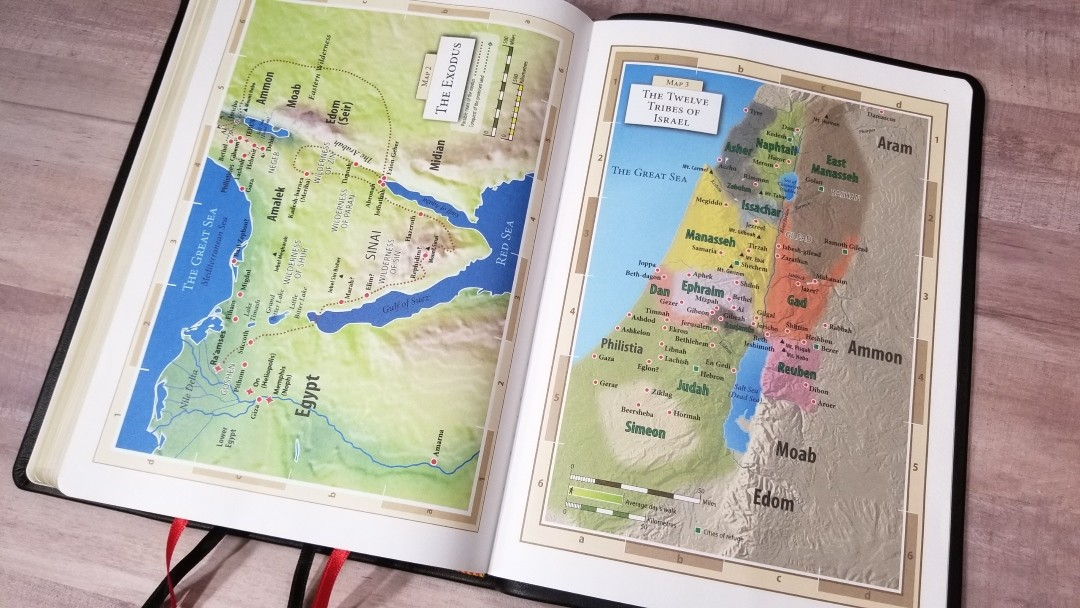
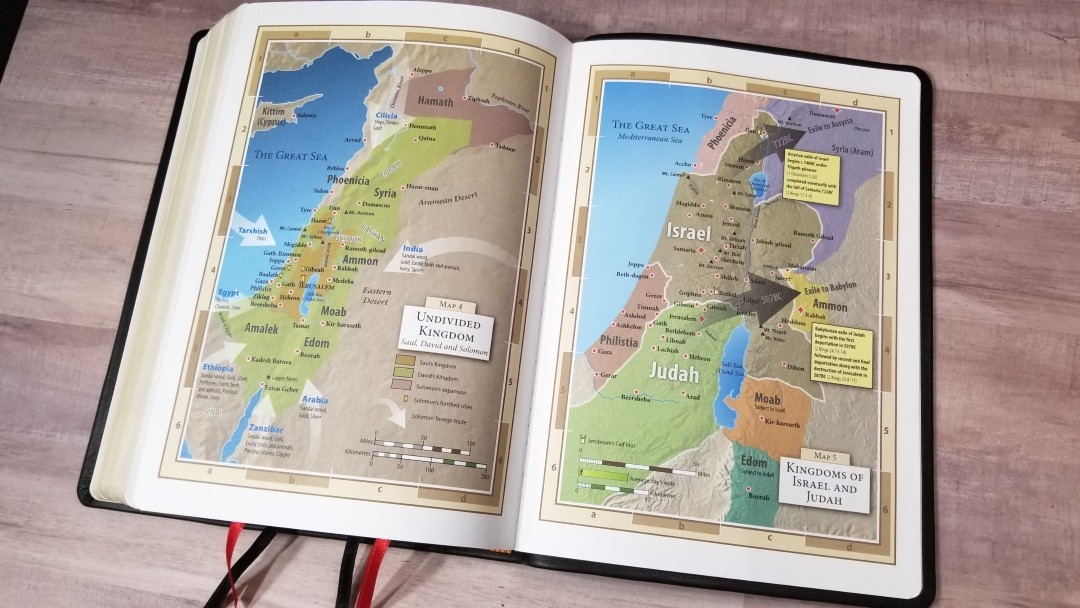

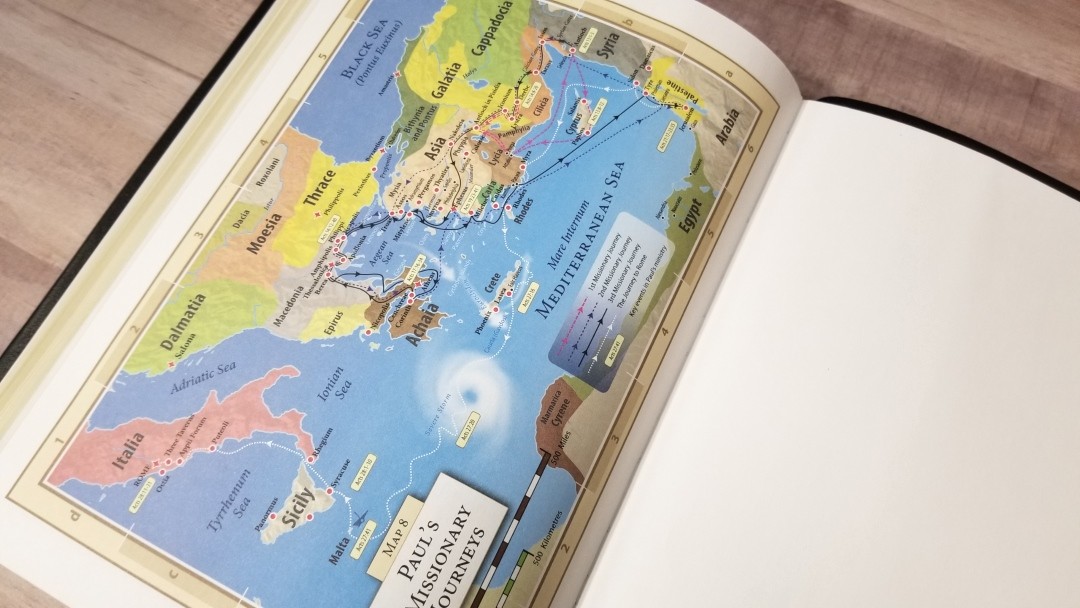
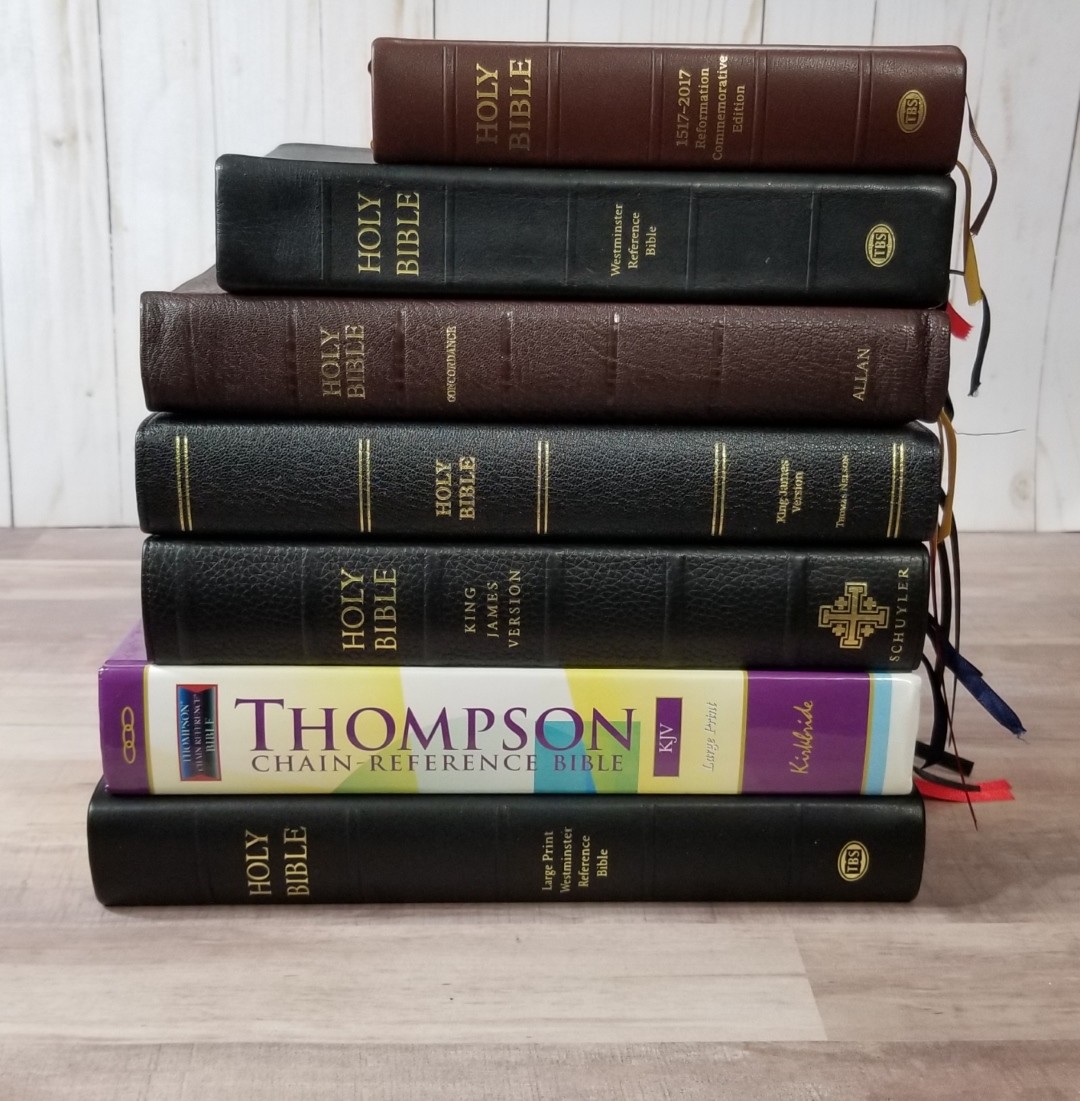
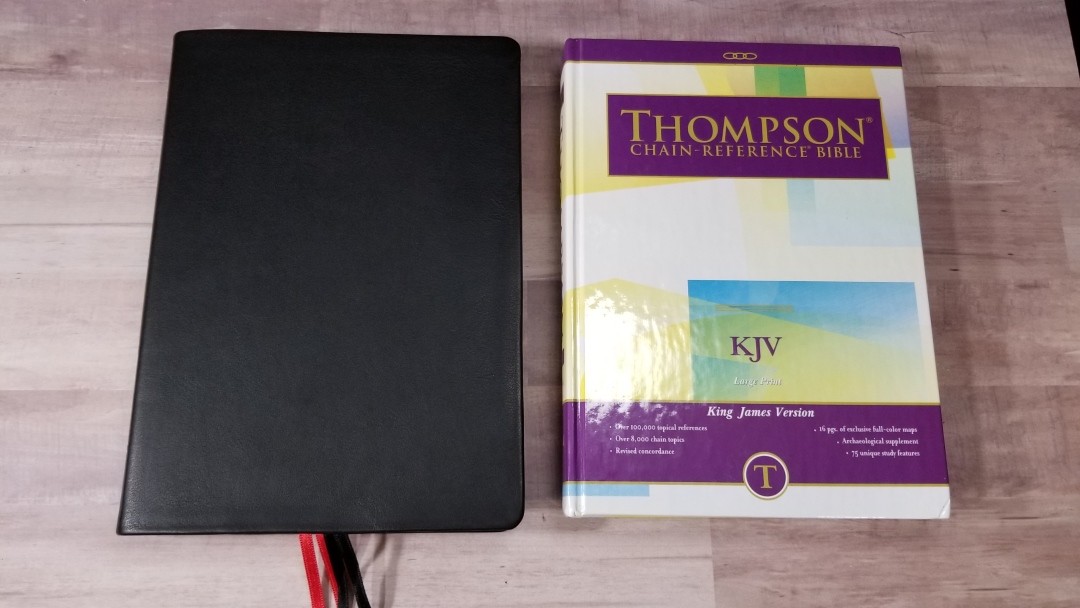
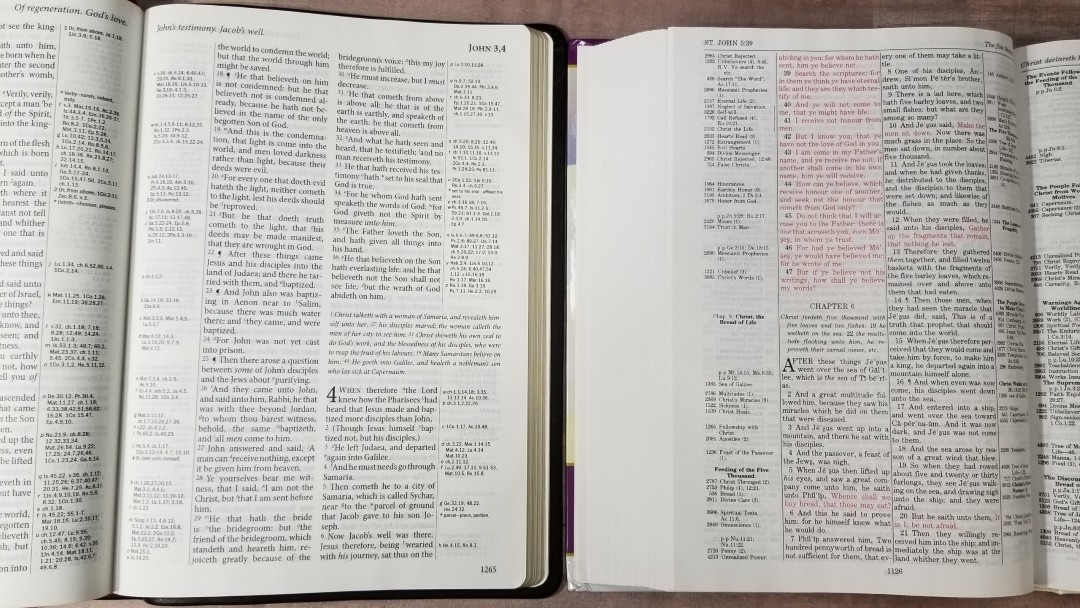
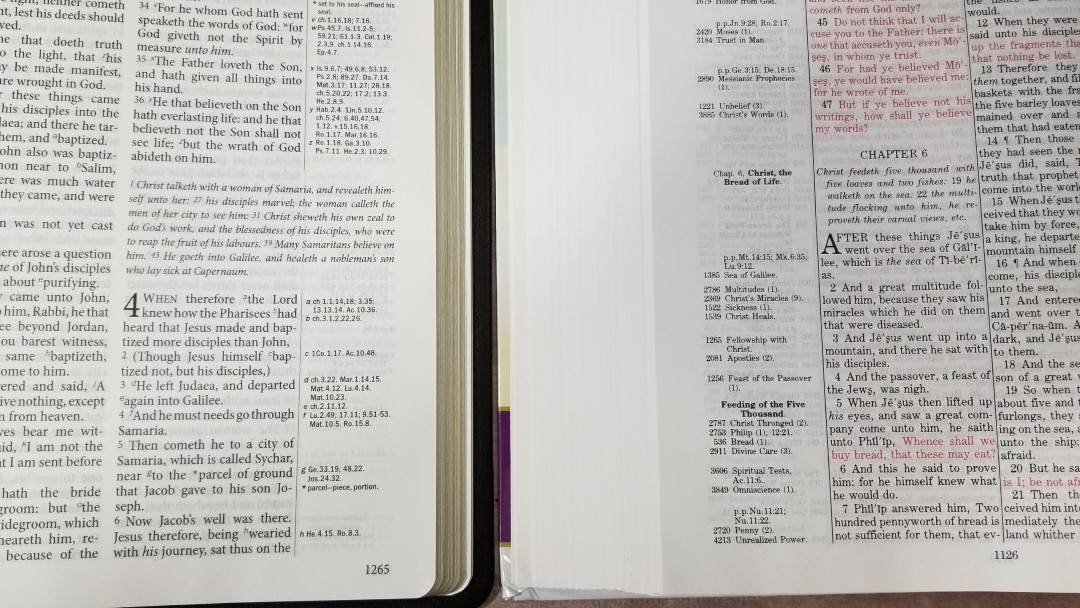
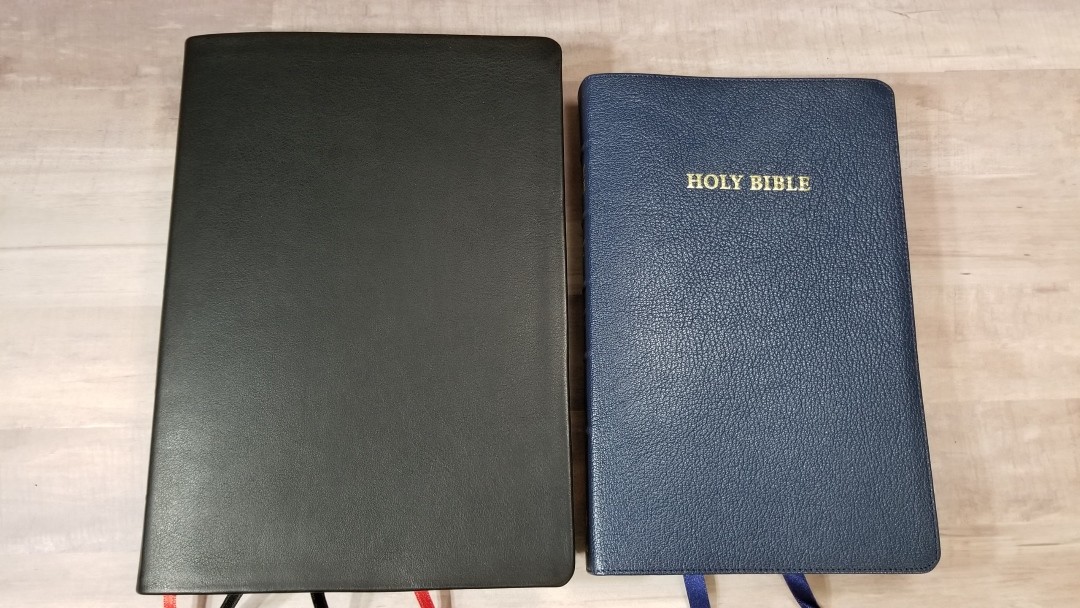
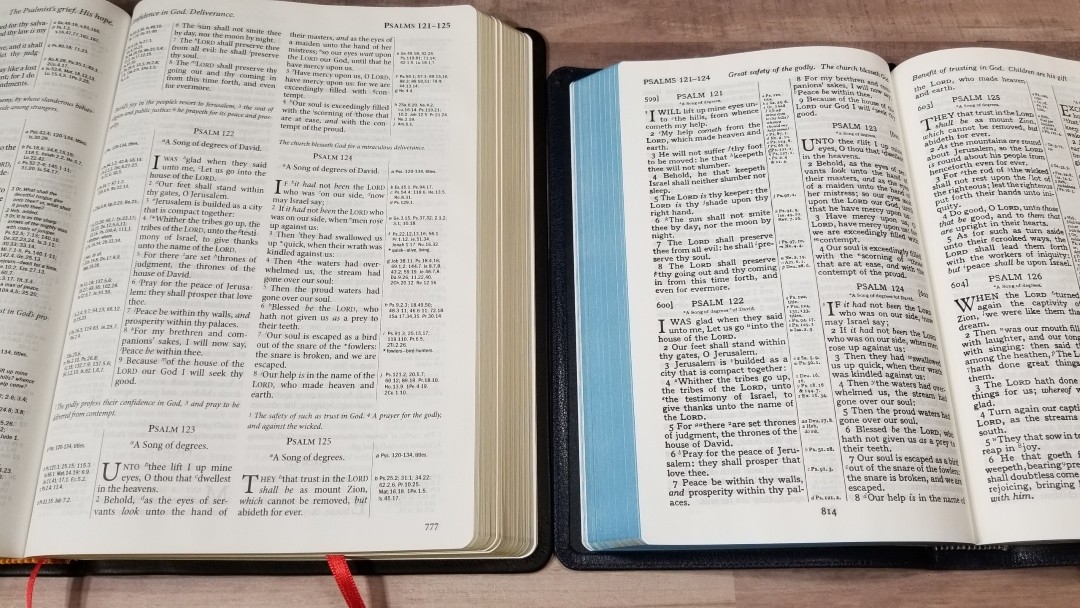
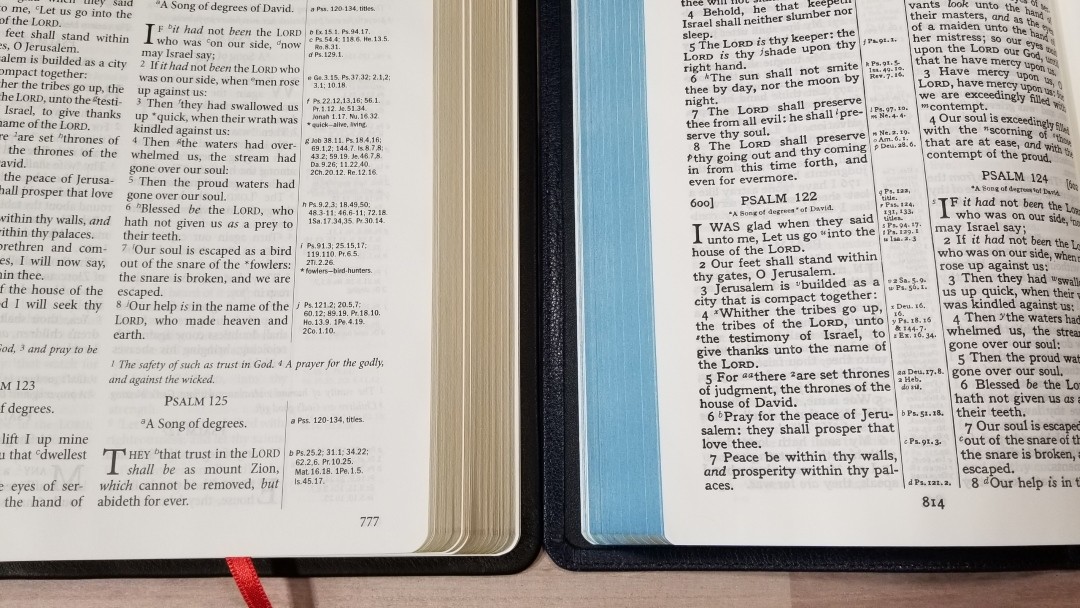
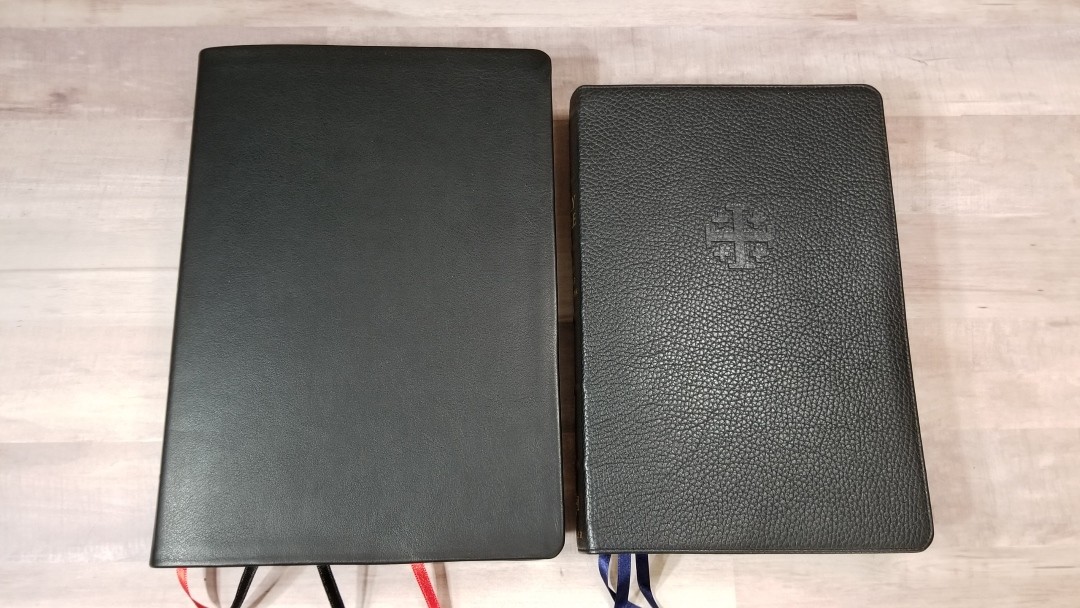
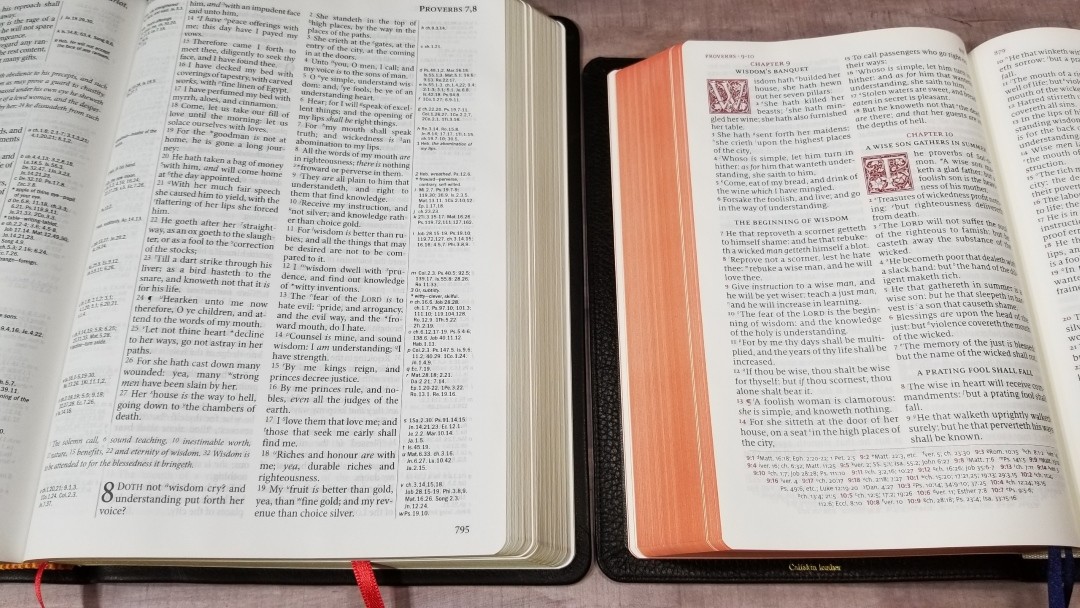
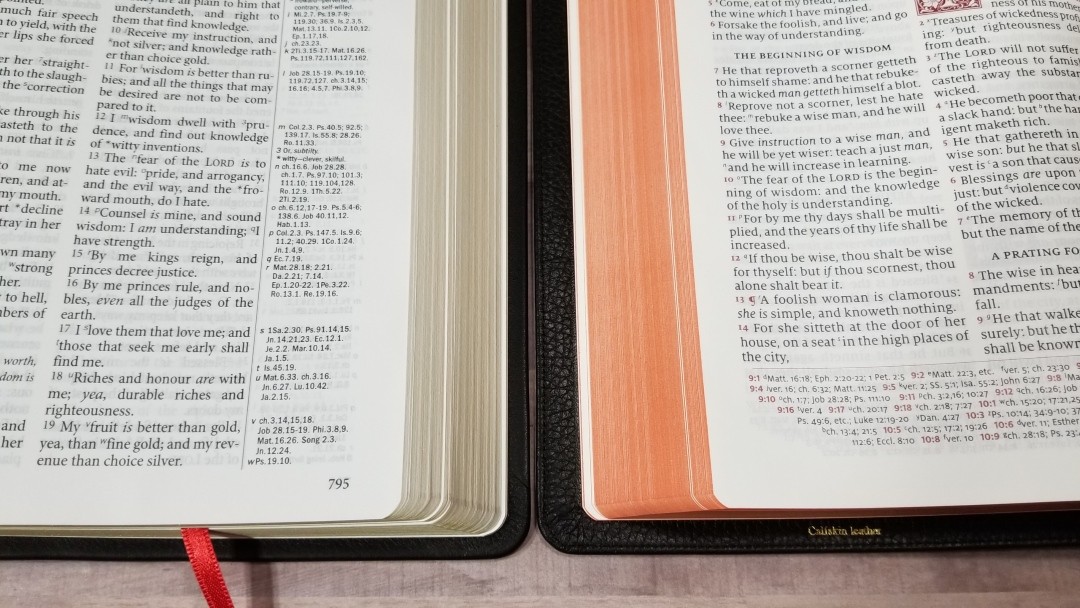
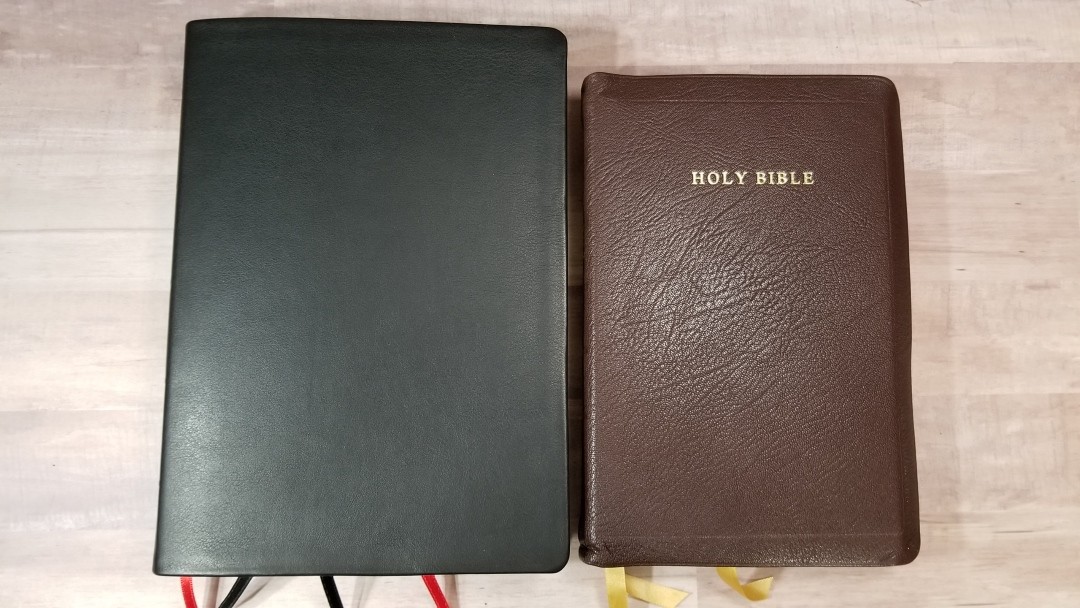
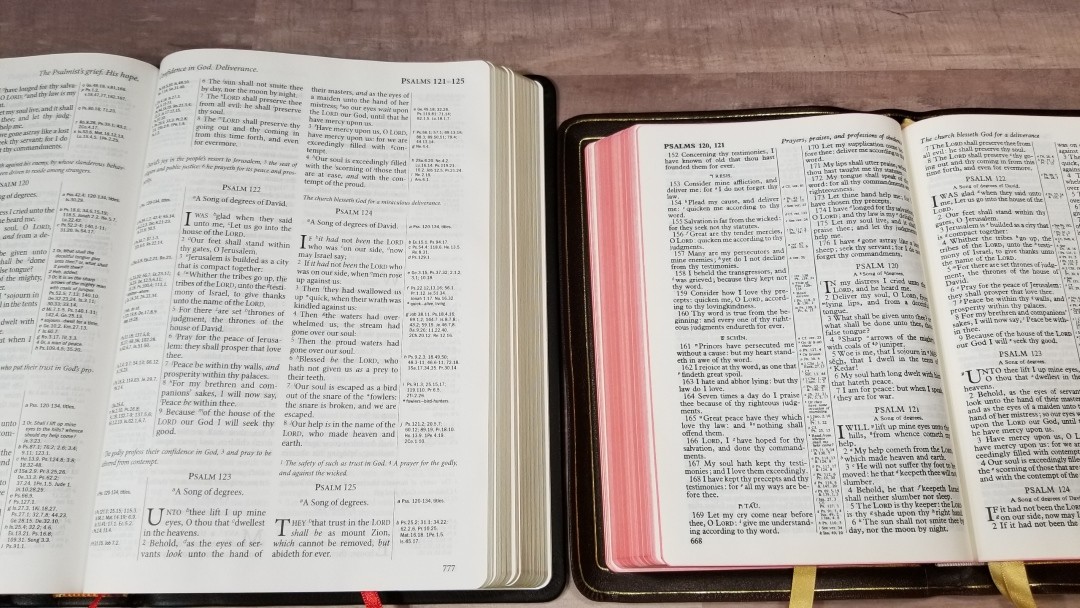
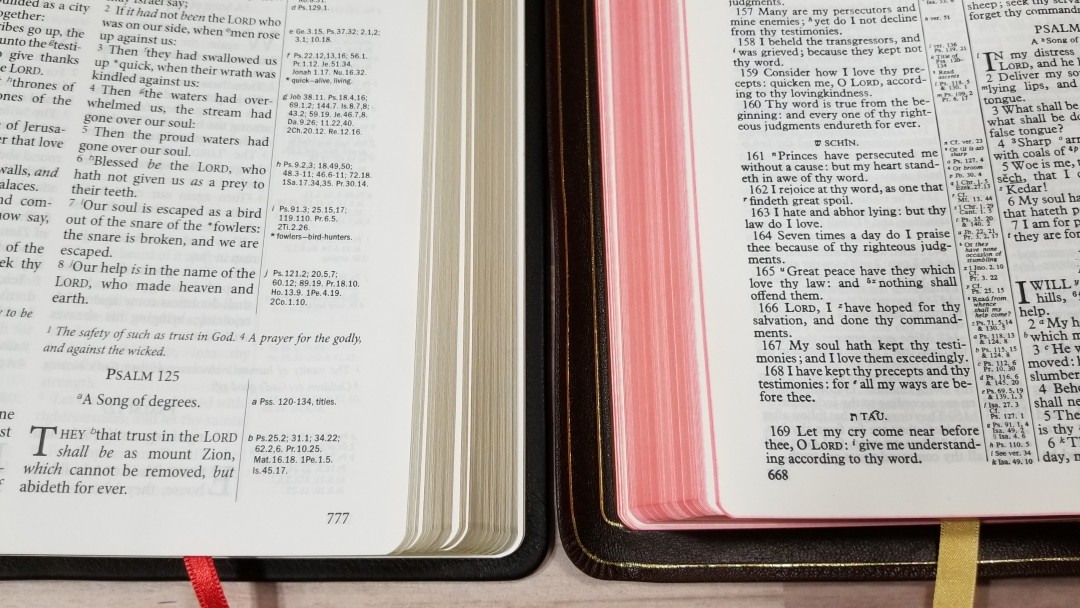
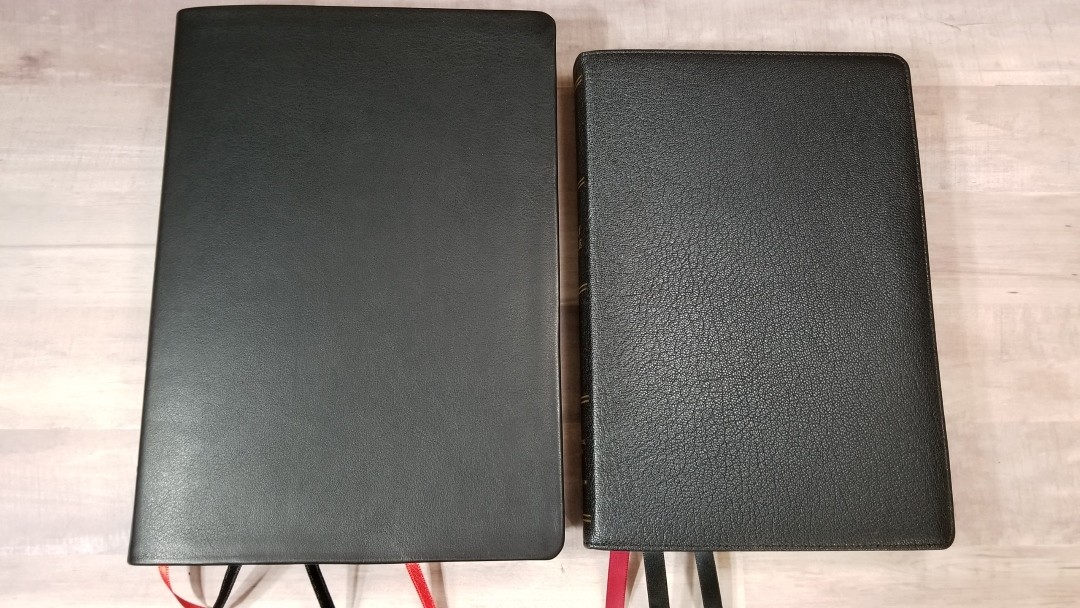
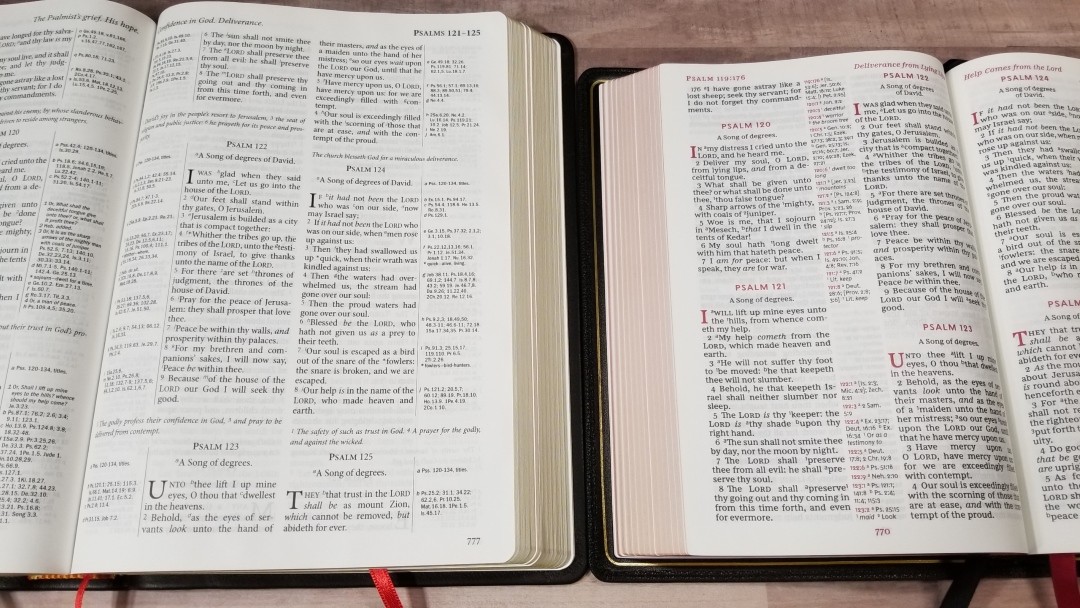
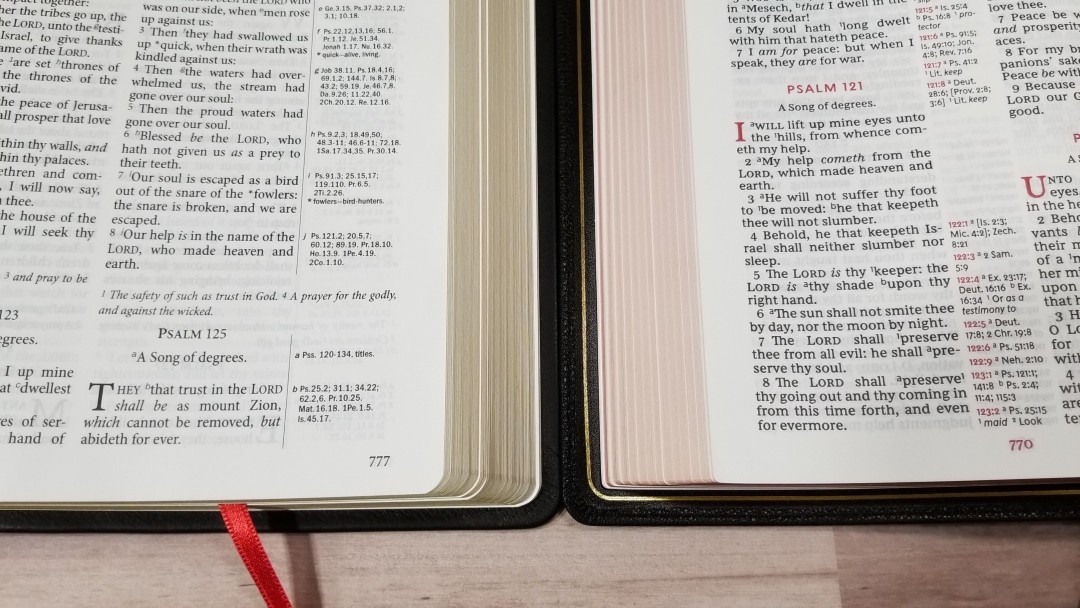
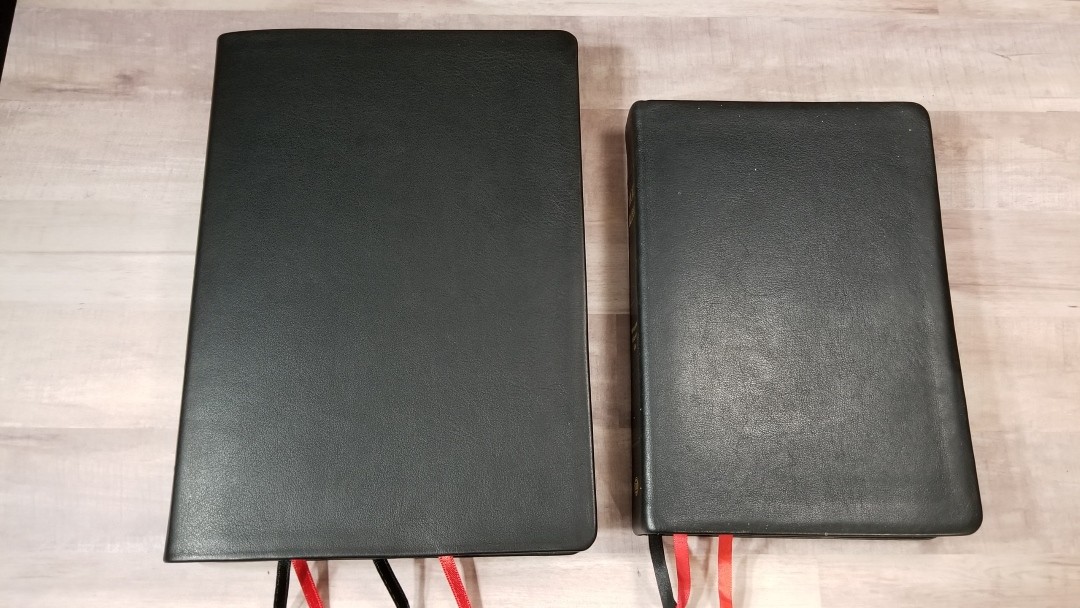
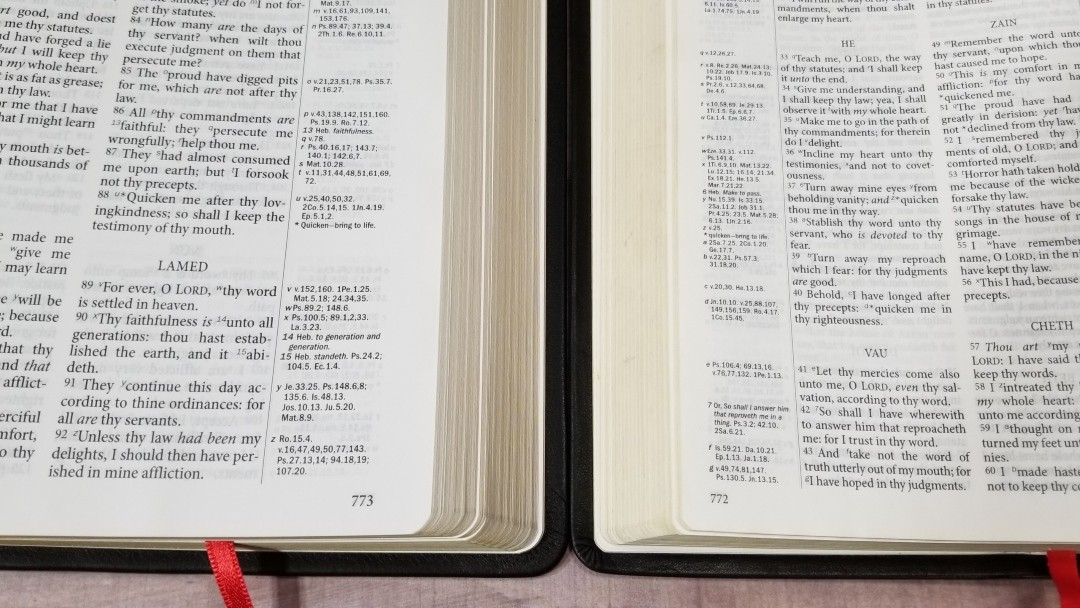
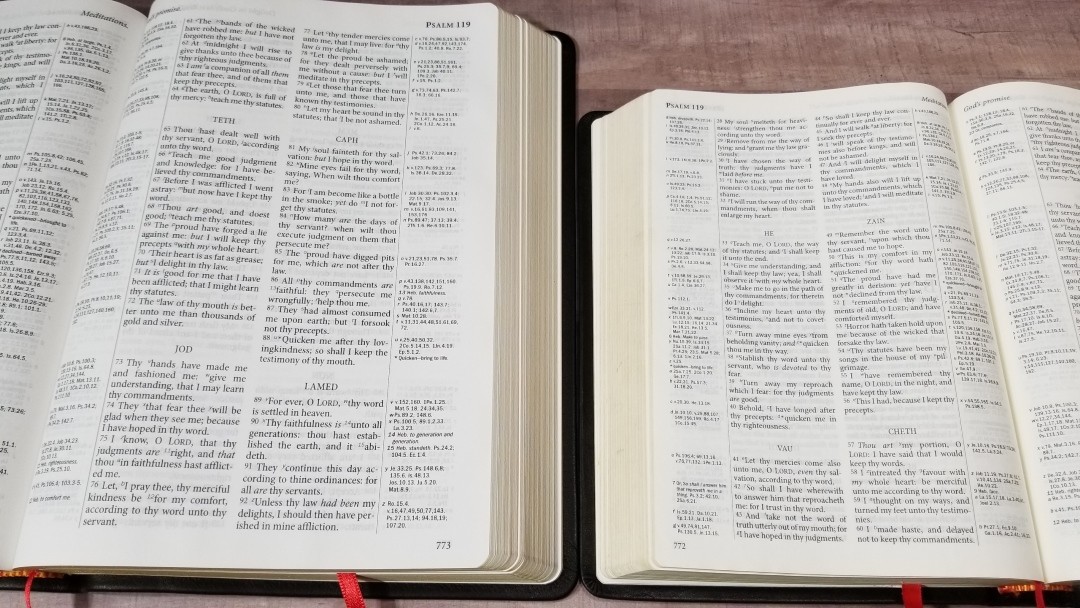
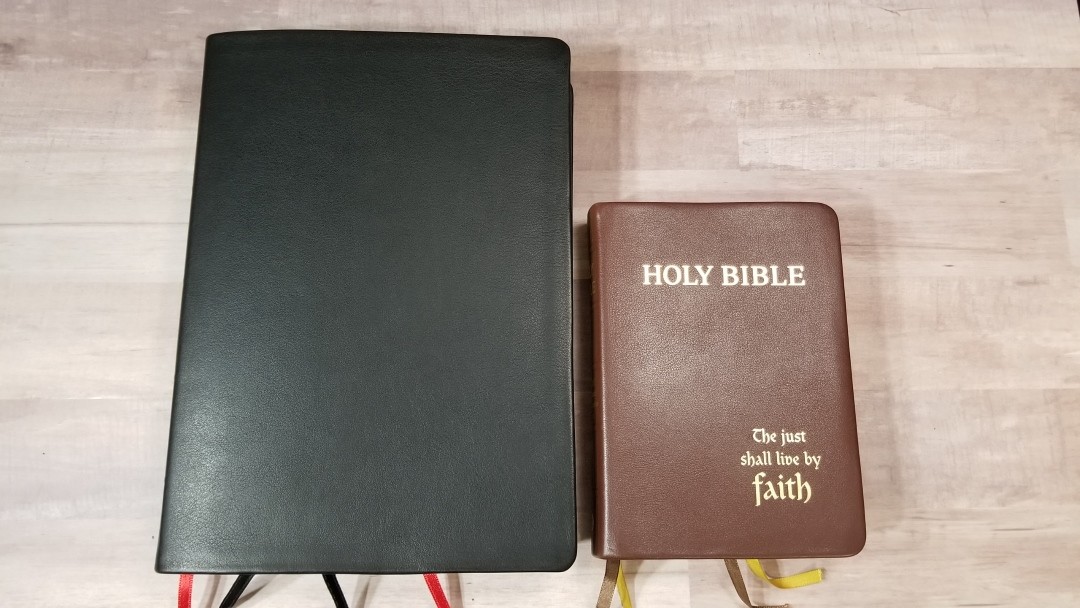
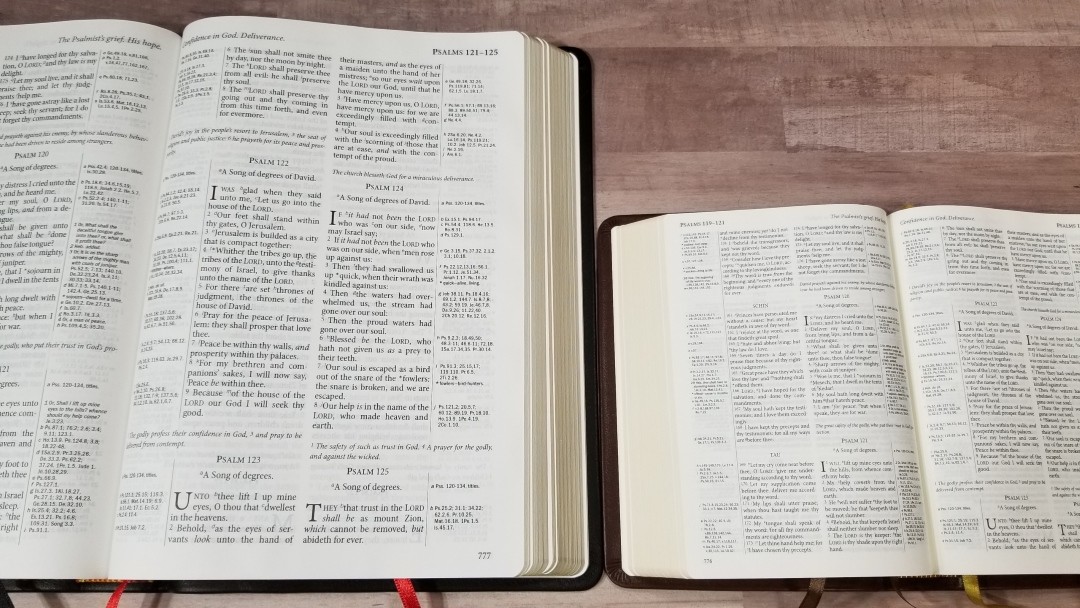
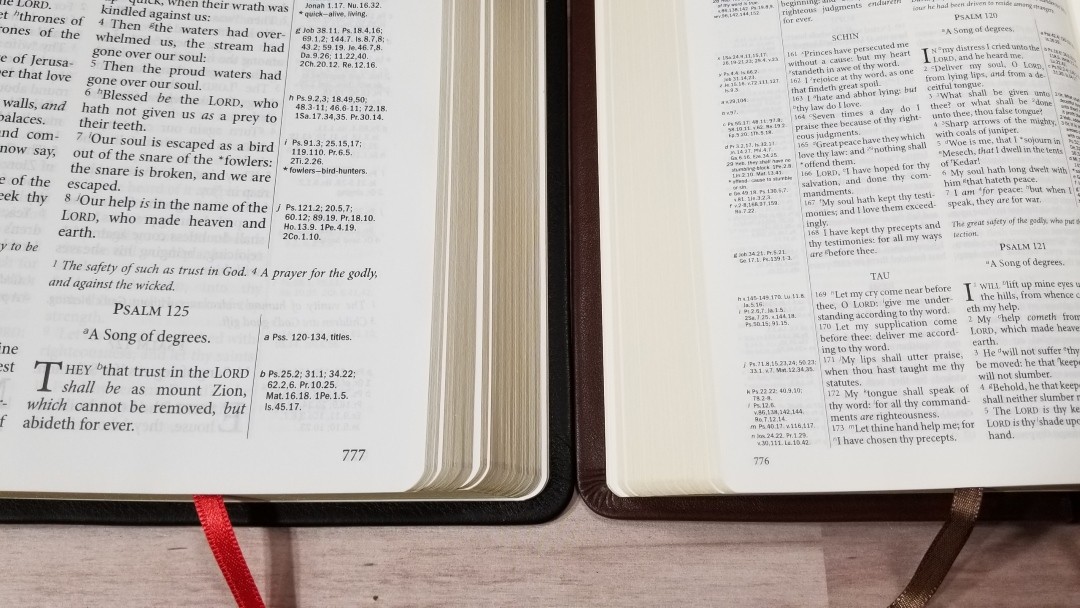
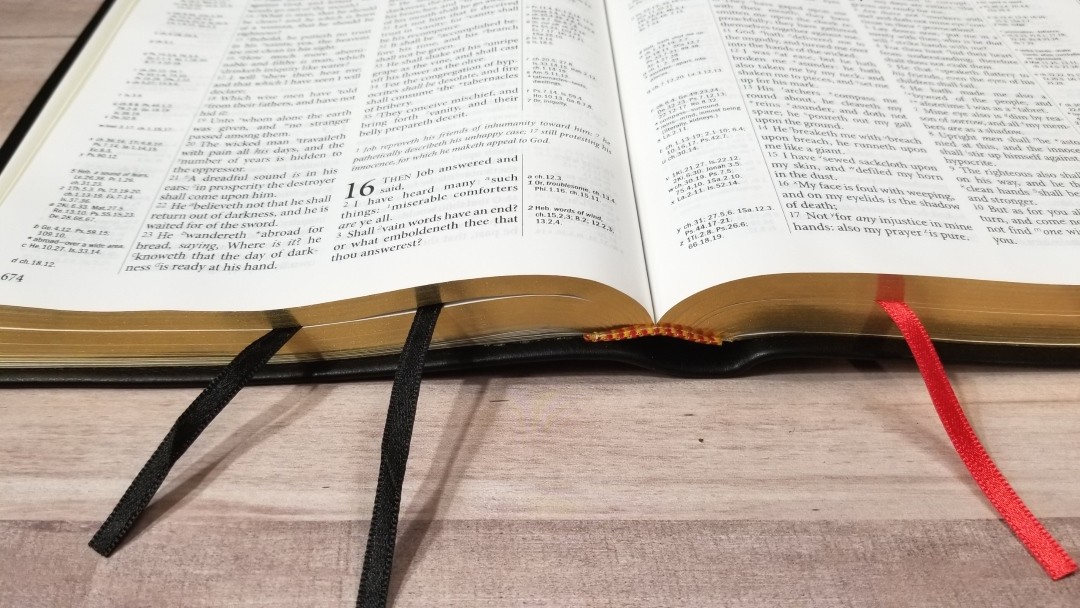

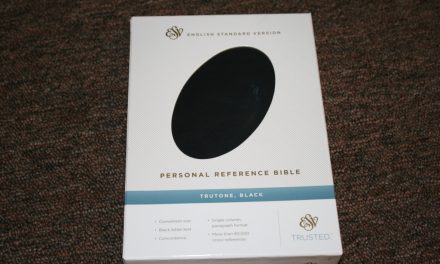

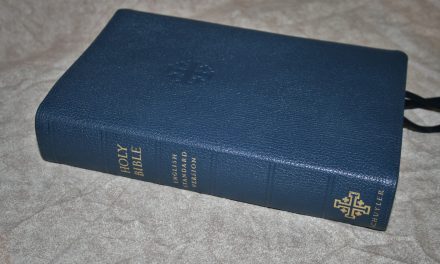






FINALLY it is here! Bought it.
When you cant really afford an expensive Bible 26 bucks for the hardback is the bomb. It is a best buy. I am assuming everything is the same inside paper/print.
Oh, why dont you make a Budget Best Buy review, especially with Christmas coming?
That’s awesome! I’m glad you like it. Great idea!
I would buy it in seconds had TBS printed the Westminster KJV Large Print with Jesus Christ’s words in red letter.
They missed the Translators to the Reader and the Concordance from the Large Print Westminster.
Chacon à son goût, as the French say. I very much prefer black type, for several reasons. I understand that the red-letter practice was begun by an American – in the nineteenth century? I think that we have Bibles with “God’s words” in blue, Jesus’ words in red, and others’ words in black. Let every man be fully persuaded in his own mind. But, perhaps publishers should offer us more choice – Bibles printed in the USA tend to be red-letter.
I understand that red-letter Bibles were a nineteenth(?) century invention by an American gentleman. I’m afraid that we British have never really cared for them; but, as many of our Bibles are now produced in America, red-letter editions are becoming more common.
Pastor Brown,
Thanks so much for your labors. Love reading your reviews.
Curious about how this one does in the lap. Looks great on a desk, but I’m fearful it could be too large to sit and hold. Is it firm enough so it doesn’t flop around?
Thanks again.
Hi Brian. It’s perfect as a lap Bible. The size works great for laying across my legs with both feet on the floor or with one foot propped up on my knee. It’s stiff enough that it lays perfectly flat with no trouble.
I have a bean bag thing that I put on my lap, and I can quite easily read big books! My wife says that there are even better beanbags or similar available, that fit around the book to maximise “the reading experience”; so, I might try to find one!…….By my armchair, Imhave a table, usually groaning with books brought “temporarily” from my study; and a friend has suggested that I get a handyman to build me a sort of slanted gantry table on castors, rather like a hospital device, for armchair “study”. Sounds good to me, but would that be the lazy man’s way?
That sounds useful, not lazy. 🙂 In my opinion, anything that can remove the difficulty of handling books can help improve your time in using those books.
Is the paper and print quality of the Westminster reference Bible in hardcover version any different than the paper and print quality in the Westminster reference Bible in calf skin leather?
Is there any difference in print bleed through between the two?
If anyone can answer these questions for me it would be greatly appreciated.
Hi Jeff. They’re the same. They use the same blocks for both editions.
Thank you Randy. So no disappointment if I buy the hardcover copy then?
No disappointment. The only differences are the hardcover, number of ribbons (2 vs 4), and white pages edges that are square instead of rounded corners.
Thank you Randy, I purchased the CBP`s Turquoise Reference Bible I have the Large Print Westminster Reference Bible and the Thompson chain reference Bible, love them all, now the issue is which do I have as my main Bible. Thank you for you reviews.
Just received my copy in the mail today. Bible is just as described in the post. Awesome Bible.
Excellent! I’m glad you like it!
The build quality of having Smyth Sewn Binding and Meriva Calfskin Cover, makes the TBS Large Print Westminster Bible a pleasure to own, to read and use for my daily devotion. I love carrying this bible everyday, as it is affordable enough that I don’t have to worry about being damaged. The paste down lining is vinyl to cut down on the cost of manufacturing and has worn fairly well, there are more expensive bibles on the market ($600 Canadian and over) but why spend more with smaller font?
There is do doubt that the TBS Westminster series has attracted many to read the AV/KJV as a sole or principal or subsidiary Bible. In all three editions, we need an expanded margin to include more glosses of “archaic” words – or, perhaps, the inclusion of the Skeat or TBS word list;, and, in the Large Print edition, we need the inclusion of the concordance – or, perhaps, a large-print edition of Cruden’s Complete Concordance. [There is an excellent edition of the 1979 revised edition of Irwin etc. still available, even used at a low price ; ISBN 0718802020.]. And what about that enhanced A4 looseleaf or interleaved desk/study edition?!
I’d love to see this in a looseleaf or interleaved edition. I don’t think they have this planned, but I’ll pass this idea along.
On the matter of concordances, I am very impressed by two concordances. The two modern versions that I use for evangelism and teaching are NIV and ESV. John Kohlenberger was an excellent concordist and he left us the excellent NIV Excellent Exhaustive Bible Concordance, ISBN 9780310262930, using the G/K numbers (a decided improvement to the Strong’s numbers) and using updated and more accurate definitions and glosses. Drayton Benner has edited the impressive ESV Exhaustive Concordance, ISBN 9781433562006, using an innovative verbal cross-reference key and having accurate definitions and glosses. Of course, if a student uses both NIV and ESV, the s/he might do very well with only either of these concordances.
Thanks for the suggestions!
There can be no doubt about one thing : along with so much candy-floss {“cotton candy”?), there are being produced superb Bible editions and superb Bible aids! How many churches (let alone individuals) have a well-stocked reading room?